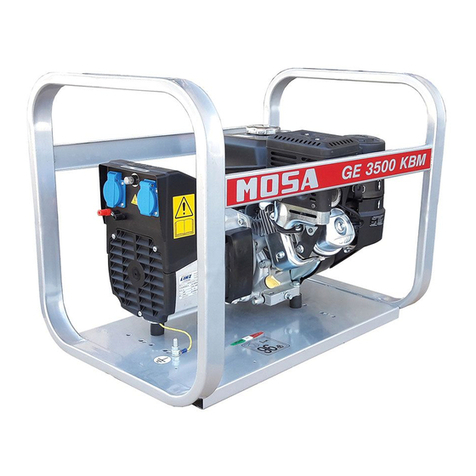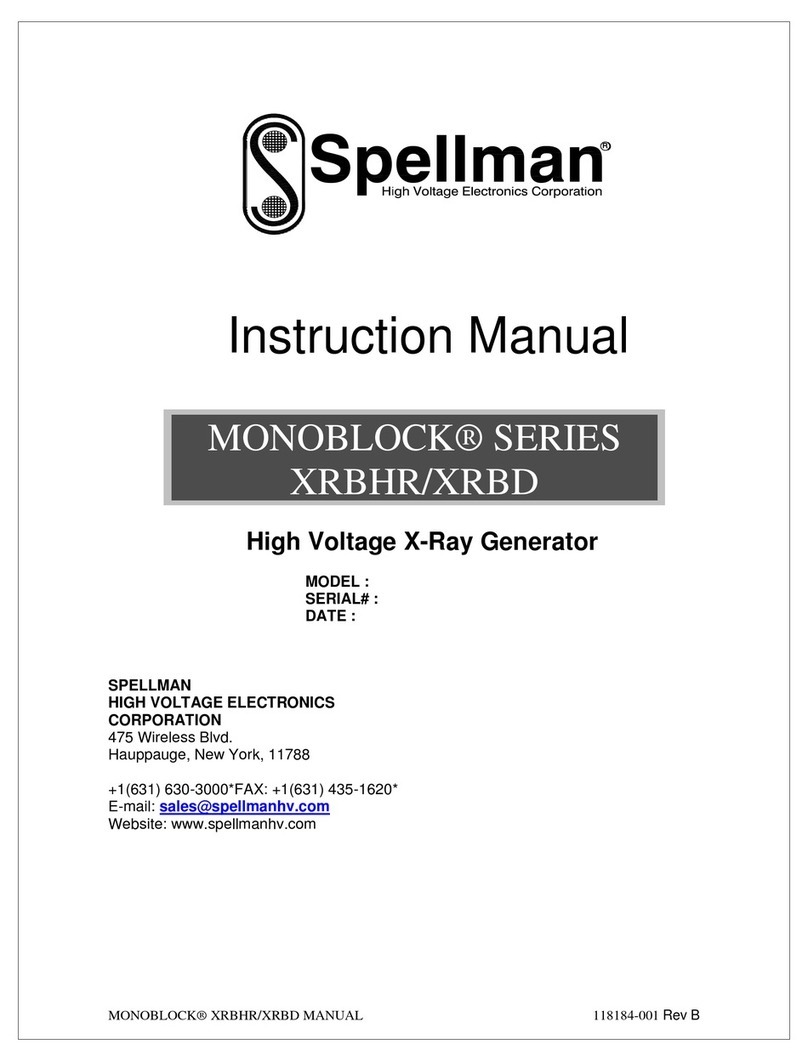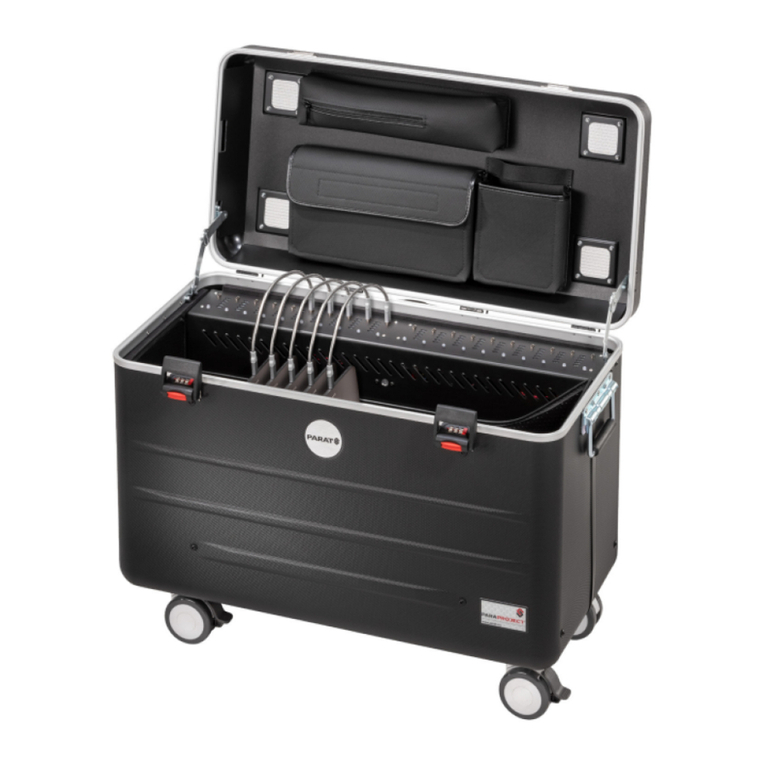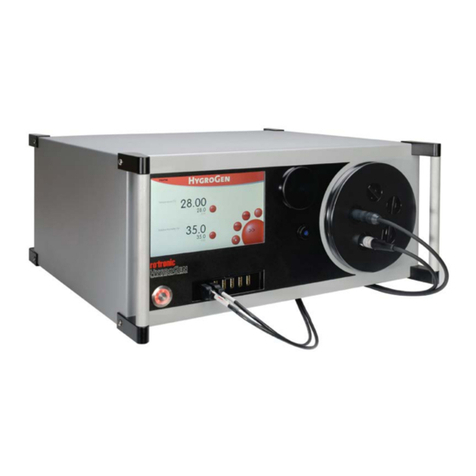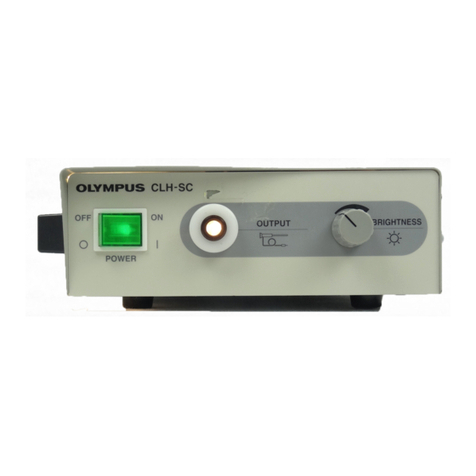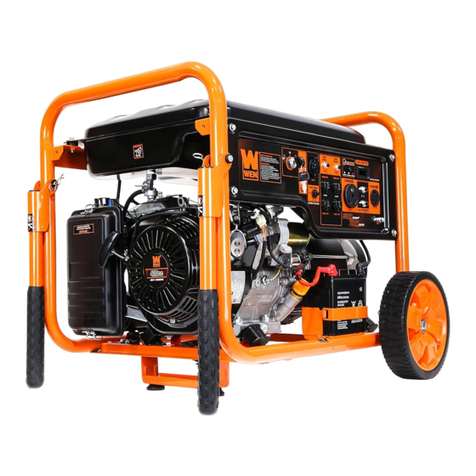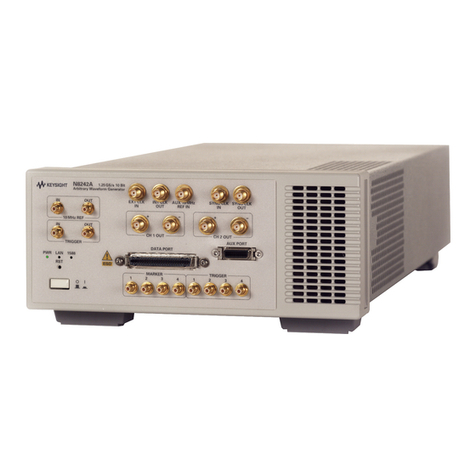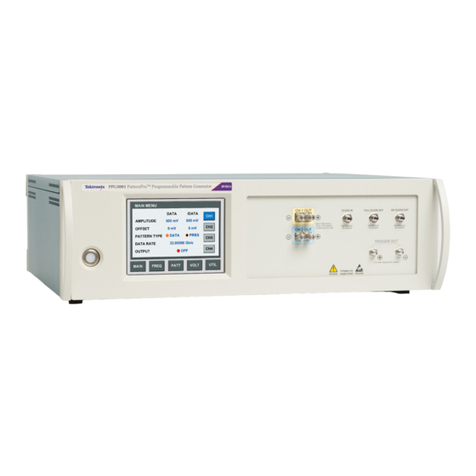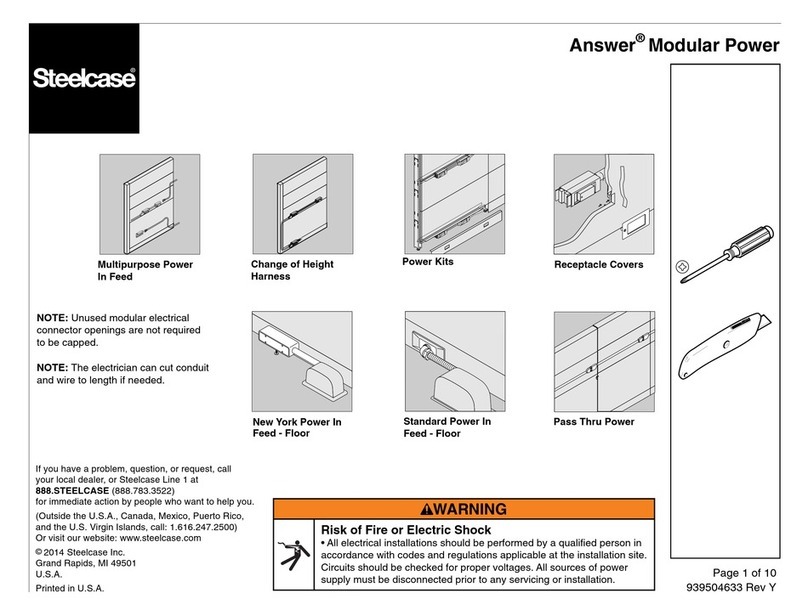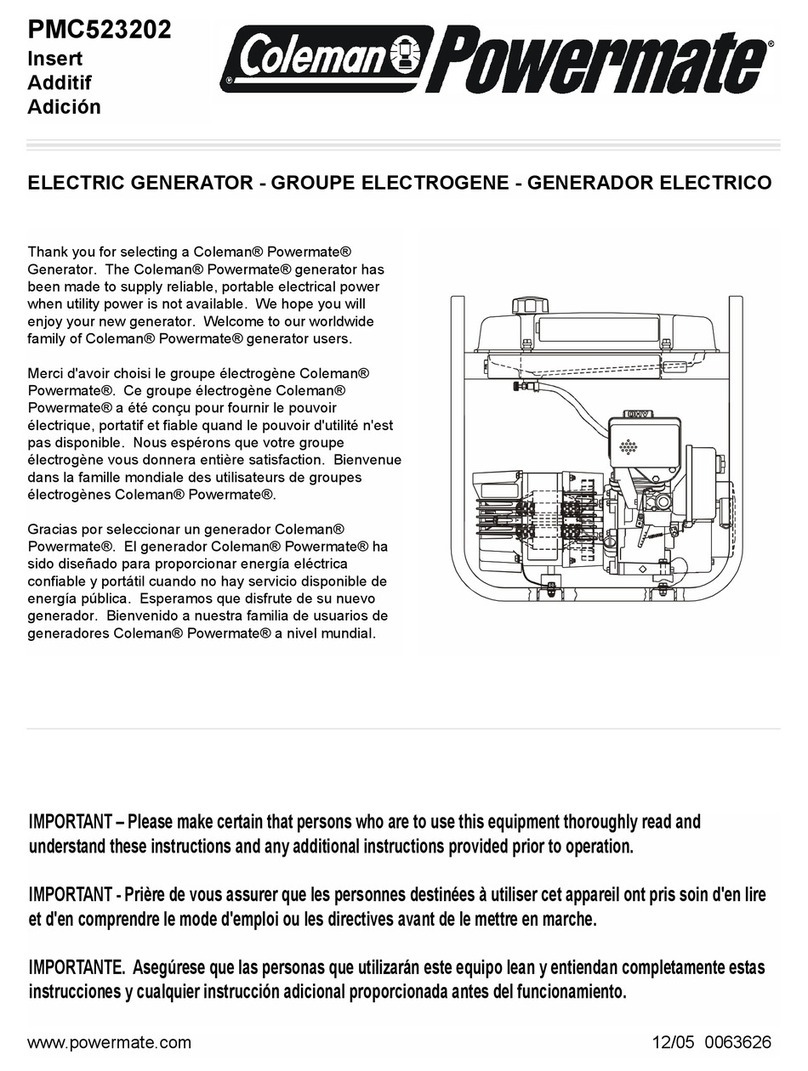Linz E1S10M G Installation guide

IT Istruzioni per l’uso e manutenzione
ALTERNATORI
Istruzioni originali
EN Operation and maintenance
ALTERNATORS
With translation of the original instructions
ES Instrucciones para el uso y mantenimiento
ALTERNADORES
Con la traducción de istrucciones originales
FR Mode d’emploi et d’entretien
ALTERNATEURS
Avec la traduction de instructions d’origine
DE Gebrauchs und wartungsanleitung
GENERATOREN
Mit Übersetzung der ursprünglichen Anweisungen
English
E1S
Español ItalianoFrançaisDeutsch
LA INSTALACIÓN DEBE SER REALIZADA SÓLO POR
PERSONAL AUTORIZADO POR LINZ ELECTRIC SPA
THE INSTALLATION MUST BE PERFORMED ONLY BY
PERSONNEL AUTHORIZED BY LINZ ELECTRIC SPA
L’INSTALLAZIONE DEVE ESSERE EFFETTUATA SOLO DA
PERSONALE AUTORIZZATO DALLA LINZ ELECTRIC SPA
L’INSTALLATION DOIT ÊTRE EFFECTUÉE UNIQUEMENT PAR
DU PERSONNEL AUTORISÉ PAR LINZ ELECTRIC SPA
DIE INSTALLATION DARF NUR DURCH AUTORISIERTES PERSONAL
ERFOLGEN VON LINZ ELECTRIC SPA

- 2 -
Arcole (Vr): Data del documento di consegna
Date of the delivery document
Fecha del documento de entrega
Date du document de livraison
Datum des Lieferdokuments
LINZ ELECTRIC Spa
Giulio Pedrollo
Rappresentante legale - custode e detentore del FascicoloTecnico
Legal representative - Keeper and holder of the Technical Dossier
Representante legal - Receptor y poseedor del ExpedienteTécnico
Représentant légal - Responsable et détenteur du DossierTechnique
Rechtlicher Verteter - Aufbewahrer und Inhaber der technischen Akte
DECLARATION OF CONFORMITY
AND INCORPORATION
The manufacturer LINZ ELECTRIC Spa - Viale
del Lavoro, 30 - 37040 Arcole (VR) Italy,
declares that the components described in this
manual are manufactured in compliance with
standards: EN 60034-1, EN 60204-1, EN
61000-6-2, EN 61000-6-4, EN 55014-1, EN
55011.
They are therefore in conformity with the Direc-
tives:
- 2006/42/EC (Machinery Directive);
- 2014/35/UE (LowVoltage);
- 2014/30/UE (Electromagnetic Compatibil-
ity).
Such conformity, the use of these ranges of
components in machines that apply the Direc-
tive 2006/42/EC, provided that their integration
or their incorporation and/or assembly con-
forms to, among other things, the rules of EN
60204 «Electrical equipment of Machines» and
our installation instructions.
The components dened above can not be put
into service until the machinery into which they
are incorporated has been declared in conform-
ity with the applicable directives.
Note: When the components are fed with
specially adapted electronic converters and/or
subservient to electronic monitoring and con-
trol systems must be installed by a professional
whoassumes responsibilityfor compliancewith
the rules on electromagnetic compatibility
regulationsofthe country inwhichit isinstalled
machine.
DÉCLARATION DE CONFORMITÉ
ET CONSTITUTION
Le fabricant LINZ ELECTRIC Spa - Viale del
Lavoro, 30 - 37040 Arcole ( VR) Italie,
déclareque leséléments décritsdans cemanuel
sont fabriqués en conformité avec les normes:
EN 60034-1, EN 60204-1, EN 61000-6-2, EN
61000-6-4, EN 55014-1, EN 55011.
Ils sont donc en conformité avec les directives :
- 2006/42/CE (Directive machines);
- 2014/35/UE (Basse tension);
- 2014/30/UE (Compatibilité Electromagné-
tique).
Cetteconformité,l’utilisation de cesgammes de
composants dans les machines qui appliquent
la directive 2006/42/CE, à condition que leur
intégration ou leur incorporation et/ou le
montage est conforme, entre autres choses, les
règles de eN 60204 «Equipement électrique des
machines» et nos instructions d’installation.
Les composants dénis ci-dessus ne peuvent
pas être mis en service avant que la machine
dans laquelle ils sont incorporés a été déclarée
conforme aux directives applicables.
Remarque: Lorsque les composants sont ali-
mentés par des convertisseurs électroniques
adaptés et/ou asservis à des systèmes de sur-
veillance et de contrôle électronique doit être
installé par un professionnel qui assume la res-
ponsabilité de la conformité avec les règles sur
lesrèglesde lacompatibilitéélectromagnétique
du pays dans lequel il est installé machine.
DECLARACIÓN DE CONFORMIDAD
E INCORPORACIÓN
El fabricante LINZ ELECTRIC Spa - Viale del
Lavoro,30- 37040Arcole(VR)Italia, declara
que los componentes descritos en este manual
son fabricados de conformidad con las normas:
EN 60034-1, EN 60204-1, EN 61000-6-2, EN
61000-6-4, EN 55014-1, EN 55011.
Son, por tanto, de conformidad con las Direc-
tivas:
- 2006/42/CE (Directiva máquinas);
- 2014/35/UE (BajaTensión);
- 2014/30/UE (Compatibilidad Electromag-
nética).
Tal conformidad, el uso de estas gamas de com-
ponentes en máquinas que aplican la Directiva
2006/42/CE,a condiciónde quesu integracióno
su incorporación y/o montaje se ajusta a, entre
otras cosas, las normas de EN 60204 «Equipo
Eléctrico de las Máquinas» y las instrucciones
de instalación.
Los componentes denidos anteriormente no
pueden ser puestos en servicio hasta que la
maquinaria en la que están incorporados haya
sidodeclaradaen conformidadconlasdirectivas
aplicables.
Nota: Cuando los componentes son alimenta-
dos con convertidores electrónicos adaptados
y/o amoldarse a los sistemas de supervisión y
control electrónico debe ser instalado por un
profesional que asume la responsabilidad por el
cumplimiento de las normas relativas a la nor-
mativa de compatibilidad electromagnética del
país en el que está instalado máquina.
KONFORMITÄTSERKLÄRUNG
UND EINGLIEDERUNG
Der Hersteller LINZ ELECTRIC Spa - Viale del
Lavoro , 30 - 37040 Arcole (VR) Italien, er-
klärt, dass die in diesem Handbuch beschriebe-
nenKomponentenwerdenin Übereinstimmung
mit den Normen: EN 60034-1, EN 60204-1,
EN 61000-6-2, EN 61000-6-4, EN 55014-1,
EN 55011. Sie sind daher in Übereinstimmung
mit den Richtlinien:
- 2006/42/EG (Maschinenrichtlinie);
- 2014/35/UE (Niederspannung);
- 2014/30/UE (Elektromagnetische Verträg-
lichkeit).
Solche Konformität, die Verwendung dieser
Bereiche von Komponenten in Maschinen, die
in der Richtlinie 2006/42/EG gelten, vorausge-
setzt, dass ihre Integration oder deren Einbau
und/oder Montage entspricht, unter anderem
den Regeln der EN 60204 «Elektrische Ausrüs-
tung von Maschinen» und unsere Installations-
anweisungen. Die oben denierten Komponen-
ten nicht in Betrieb genommen werden, bis die
Maschine, in die sie eingebaut werden, ist in
Übereinstimmung mit den geltenden Richtlini-
en erklärt werden.
Hinweis: Wenn die Komponenten mit speziell
angepassten elektronischen Konvertern und/
oder unterwürg elektronische Überwachungs-
und Kontrollsysteme eingespeist muss von
einemFachmann,der dieVerantwortung fürdie
Einhaltung der Vorschriften zur elektromagne-
tischen Verträglichkeit Vorschriften des Landes
geht davon aus , in dem es installiert ist, instal-
liert werden Maschine.
DICHIARAZIONE DI CONFORMITÀ
E DI INCORPORAZIONE
Il costruttore LINZ ELECTRIC Spa - Viale del
Lavoro, 30 - 37040 Arcole (Vr) Italia, dichia-
rache icomponentidescritti inquesto manuale,
sono costruiti in osservanza alle norme: EN
60034-1, EN 60204-1, EN 61000-6-2, EN
61000-6-4, EN 55014-1, EN 55011.
Sono quindi conformi alle Direttive:
- 2006/42/CE (Direttiva Macchine);
- 2014/35/UE (BassaTensione);
- 2014/30/UE (Compatibilità Elettromagneti-
ca).
Queste conformità consentono l’uso di queste
gamme di componenti in macchine che appli-
cano la Direttiva Macchine 2006/42/CE, con
riserva chela loro integrazioneo laloro incorpo-
razione e/o assemblaggio siano eettuati con-
formemente, tra l’altro, alle regole della norma
EN 60204 «Apparecchiatura Elettrica delle Mac-
chine» e alle nostre istruzioni d’installazione.
Icomponenti sopradeniti nonpotranno essere
messi in servizio prima che la macchina in cui
sono incorporati sia stata dichiarata conforme
alle direttive applicabili.
Nota: Quando i componenti sono alimentati
con convertitori elettronici adattati e/o asserviti
a dispositivi elettronici di controllo e di coman-
do, devono essere installati da un professionista
che si assuma la responsabilità del rispetto
delle regole sulla compatibilità elettromagne-
tica vigenti nel Paese in cui viene installata la
macchina.
ITALIANO ENGLISH ESPAÑOL FRANÇAIS DEUTSCH

- 3 -
1
A B Mod. L (mm)
E1S10 2
E1S11 2
E1S13 4
2
A B
3
A B
4
A B
5
A B
6
A B
7
A B

- 4 -
12
8
9
10 11
AB
AB

- 5 -
1. MISURE DI SICUREZZA
Prima di utilizzare il gruppo elettrogeno è indispensabile leggere il manuale “Uso e manutenzione” del
gruppo elettrogenoe dell’alternatoree seguirele raccomandazioniseguenti.
⇒
Unfunzionamentosicuroedecientepuòessereraggiuntosoloselemacchinevengonoutilizzate
in modo corretto, secondo quanto previsto dai relativi manuali di “Uso e manutenzione” e dalle
normedi sicurezza.
⇒Una scarica elettrica può causare gravi danni e addirittura la morte.
⇒Èvietatotoglierelacalottadichiusuradellascatolamorsetti elegrigliedi protezionedell’alternatore
nché lo stesso è in movimento e prima di avere disattivato il sistema di avviamento del gruppo elet-
trogeno.
⇒Lamanutenzionedelgruppodeveessereeettuataesclusivamentedapersonalequalicatoespecia-
lizzato.
⇒Nonoperare conindumenti “sciolti” invicinanza delgruppoelettrogeno.
⇒
Lepersone addetteallamovimentazione devonosempreindossare guantidalavoroe scarpeantinfor-
tunistiche. Qualora il generatore o l’intero gruppo debba essere sollevato da terra, gli operai devono
usare un casco protettivo.
L’installatore nale del gruppo elettrogeno è responsabile della predisposizione di tutte le misure
necessarie a rendere l’intero impianto conforme alle vigenti norme locali di sicurezza (messa a terra,
protezionicontroilcontatto,protezionicontroleesplosioniel’incendio,arrestodiemergenza,ecc…).
Messaggi di sicurezza: Nel presente manuale useremo dei simboli che hanno il seguente signicato:
IMPORTANTE!Si riferiscead unaoperazione rischiosao pericolosache puòcausare dannial prodotto.
CAUTELA!Siriferisceadunaoperazionerischiosaopericolosachepuòdanneggiareilprodottoepuòcausa-
referiteallepersone.
ATTENZIONE! Si riferisce ad una operazione rischiosa o pericolosa che può causare gravi ferite o possi-
bilemorte.
PERICOLO!Si riferisce ad un rischio immediato che potrebbe causare gravi ferite o la morte.
2.DESCRIZIONE DELL’ALTERNATORE
Gli alternatori della serie E1S sono trifase a due e quattro poli, con spazzole e con avvolgimento ausiliario (caricato su un
Compound)che assicurala regolazionedellatensione.
Essisonocostruitiinconformitàaquantoprevistodallenorme
EN60034-1,EN60204-1,EN55014-1,EN55011,EN61000-
6-2,EN61000-6-4ed alle direttive 2006/95/CE, 2004/108/CE, e 2006/42/CE.
Ventilazione.
Assialeconaspirazionedallatooppostoaccoppiamento.
Protezione. Standard IP 21. A richiesta IP 23.
Sensodi rotazione.Sono ammessiambeduei sensidi rotazione.
Caratteristicheelettriche. Gli isolamenti sono realizzati con materiale di classe H sia nello statore che nel rotore.
Gliavvolgimentisono tropicalizzati.
Potenze. Sono riferitealle seguenticondizioni:temperatura ambientenon superiorea 40°C,altitudinenon superiorea
1000 m. s.l.m., servizio continuo a
Cosф
= 0.8.
Sovraccarichi
Si accetta generalmente un sovraccarico del 10% per 1 ora ogni 6 ore.
C
aratteristichemeccaniche.
La cassa e gli scudi sono in lega di alluminio resistente alle vibrazioni. L’albero è in acciaio ad alta resistenza.
Il rotore è particolarmente robusto per resistere alla velocità di fuga dei motori di trascinamento ed è dotato di una
gabbia di smorzamento che permette un buon funzionamento anche con carichi monofase distorcenti. I cuscinetti
sono lubricati a vita.
Funzionamentiin ambientiparticolari.
Nel caso l’alternatore debba funzionare ad una altitudine superiore ai 1000 m s.l.m. è necessario attuare una riduzione
della potenza erogata del 4% ogni 500 metri di incremento. Quando la temperatura dell’ambiente è superiore a 40° C si
deve ridurre la potenza erogata dall’alternatore del 4% ogni 5°C di incremento.
MESSA INSERVIZIO
Leseguentioperazionidicontrolloedimessainserviziodevonoessereeseguitesolodapersonalequalicato.
⇒L’alternatoredovràessere installatoinun locale conpossibilità discambio dell’aria conl’atmosferaperimpedire che
la temperatura ambiente superi i valori previsti dalle norme.
⇒Bisogna fare attenzione che leaperturepreviste per l’aspirazionee loscaricodell’arianonsianomaiostruitee che la
tecnica prescelta per il piazzamento dell’alternatore sia tale da evitare l’aspirazione diretta dell’aria calda in uscita
dall’alternatore stesso e/o dal motore primo.
⇒Prima della messa infunzione è necessario controllarevisivamentee manualmentechetuttii morsettidellediverse
morsettieresianoserratiregolarmentee chenonesista impedimentoalcunoallarotazione delrotore. Nel casol’al-
ternatoresiastato inutilizzatoper lungo tempo,prima dimetterlo inserviziocontrollarelaresistenza diisolamento
verso massadegliavvolgimentitenendopresentecheognisingolapartedacontrollare deveessereisolatadallealtre.
Questocontrollosidovràeseguireconlostrumentoa500V.c.c.denominatoMegger.Normalmentevengonoritenuti
sucientemente isolati gli avvolgimenti chehannoun valore di resistenza verso massa ≥1 MΩ. Nel casoche il dato
rilevatosiainferiore ènecessario procederead un ripristinodell’isolamentoasciugandol’avvolgimentoutilizzando
per es. un forno a 60 - 80°C (o facendo circolare nello stesso un adatto valore di corrente elettrica ottenuta da una
sorgenteausiliaria).Ènecessariovericarechelepartimetallichedell’alternatore e lamassadell’interogrupposiano
collegatial circuitodi terrae chequest’ultimorisponda alleprescrizioni dilegge.
Errori o dimenticanze nella messa a terra possono causare conseguenze anche mortali.
3. ISTRUZIONI PER IL MONTAGGIO
Ilmontaggio deveessereeettuato dapersone qualicatedopo laletturadel manuale.
Formacostruttiva B3/B14
La forma costruttiva B3/B14 obbliga all’uso di un giunto elastico tra motore primo e alternatore.
Ilgiuntoelasticonondovràdareorigineaforzeassialioradialiduranteilfunzionamentoedovràesseremontatorigidamente
sullasporgenza dell’alberodell’alternatore.Si consigliadi eseguirel’assemblaggioseguendole seguentifasi:
1) Applicaresull’alternatoreilsemigiuntoe lacampana diallineamento come rappresentato nellagura1A.
Nel posizionamento del semigiunto sull’alternatore tenere presente che il rotore, ad accoppiamento completato,
deve poter conservare la possibilità di dilatarsi assialmente verso il cuscinetto lato opposto accoppiamento; perché
ciò sia possibile è necessario che a montaggio nito la sporgenza dell’albero sia posizionata rispetto alle lavorazioni
del coperchio, come rappresentato nella gura1Be relativatabella.
2) Applicare sulla parte rotante del motore diesel il relativo semi-giunto come indicato in gura2A.
3) Montare itasselli elasticidel giunto.
4) Accoppiare l’alternatore al motore primo ssando con le apposite viti la campanadi accoppiamento (vedigura2B).
5) Fissare con adatti antivibranti l’insieme motore-alternatore alla base facendo attenzione che non si creino tensioni
Italiano
ITALIANO

- 6 -
tendenti adeformare ilnaturaleallineamento delledue macchine.
6) Osservarecheilcuscinettolatooppostoaccoppiamentodell’alternatoreabbiailprevistospaziodidilatazione(minimo
2 mm) e sia precaricato dalla molla di precarico.
Formacostruttiva B3/B9
Tale forma costruttiva prevede l’accoppiamento diretto tra motore primo e alternatore. Si consiglia di procedere all’as-
semblaggionel seguentemodo:
1) Fissare il coperchio «C» al motore primo come rappresentato nella gura 3A.
2) Applicareiltirante (13)perilssaggioassialedelrotoreavvitandoloafondosulla sporgenza dell’albero delmotorecome
rappresentatonella gura3B.
3) Fissare l’alternatore al suo coperchio con i 4 bulloni previsti come indicato nella gura4A.
4) Bloccareassialmenteilrotoreapplicandolarondella(50)eserrandoildadoautobloccante(51)conchiavedinamometrica
(coppia di serraggio 35 Nm per tiranti M8; 55 Nm per tiranti M10 e 100 Nm per i tiranti M14) (gura4B).
Prima di applicare il dado osservare che la porzione lettata del tirante entri nel rotore permettendo
così un sicurobloccaggio. Inoltre prima delmontaggio vericare chele sediconiche diaccoppiamento
(sualternatoree motore)siano regolarie benpulite.
Forma B2
Anche tale forma prevede l’accoppiamento diretto tra motore e alternatore. Si consiglia di procedere all’assiemaggio nel
seguentemodo:
1) Controllare il corretto posizionamento del rotore con l’ausilio della tabellina riportata in gura5A.
2) Togliere eventuali mezzi di bloccaggio del rotore posti sul lato opposto accoppiamento.
3) Avvicinare l’alternatore al motore primo come rappresentato in gura 5B.
4) Centrare essare lo statore alla angia del motore primo con le apposite viti come indicato ingura6A.
5) Centrare e ssare con le apposite viti il giunto del rotore al volano del motore primo, agendo attraverso le aperture
apposite, come indicato in gura6B.
Girare ilrotorecomeindicatoingura 7Ae 7B.
CONTROLLI FINALI
Alterminedituttigliaccoppiamentisopradescrittiènecessariocontrollareilcorrettoposizionamento
assiale;sidevecioèvericareche:
1)
tra la nedel cuscinetto L.O.A. elaparete dibloccaggio assialeesista unospaziodi dilatazionedi:
2 mm per gli alternatori E1S10
3 mm per gli alternatori E1S11 ed E1S13
2) che le spazzole siano centrate sugli anelli del collettore.
4. UTILIZZAZIONE
Leoperazionidicollegamentodeicavidipotenzadevonoessereeseguitedapersonalequalicatocon
macchinadenitivamente fermaescollegataelettricamente dalcarico.
Tensione e frequenza di erogazione: questi alternatori sono predisposti per erogare esclusivamente la tensione e la
frequenzariportate intarghetta.
5. SCHEMA ELETTRICO (Figura 8)
Collegamentidei cavidi potenza
Gli alternatori E1S possono funzionare sia con collegamento a stella con neutro che a triangolo. La
morsettiera principale dovrà essere quindi collegata (a seconda dei casi) come in figura 9: A =
CollegamentoStella/Neutro; B=Collegamento Triangolo.
Tipo kVA Resistenza degli avvolgimenti Ω (20°C)
Alternatore Avvolg.
ausiliario Compound
50 Hz 60 Hz Rotore I II
E1S10M G 5,5 7 1,80 19,50 2,24 0,270 1,550
E1S10M H 7 8,5 1,24 21,00 1,83 0,141 1,550
E1S10M I 9 11 0,92 22,70 1,75 0,101 1,550
E1S10L L 10 12 0,65 23,50 1,70 0,085 1,550
E1S11M A 10 12,5 0,75 22,30 1,60 0,075 1,350
E1S11M AS 11,5 14 0,63 22,30 1,54 0,070 1,350
E1S11M B 13,5 16,5 0,46 24,60 1,47 0,043 1,350
E1S13S C/2 16 20 0,48 10,26 1,20 0,052 0,648
E1S13M D/2 22 27 0,28 12,30 1,10 0,030 0,648
E1S13M E/2 27 32 0,23 14,00 0,90 0,019 0,648
E1S13S A/4 8 9,6 1,58 5,73 1,49 0,128 0,540
E1S13S B/4 10 12 0,97 6,82 1,31 0,083 0,540
E1S13M D/4 13 16 0,61 7,95 1,20 0,046 0,540
E1S13M E/4 16 19 0,46 9,72 1,07 0,030 0,540
E1S13M F/4 20 24 0,38 9,86 1,15 0,024 0,540
Tipo kVA Dati eccitazione rotore
A vuoto Pieno carico
50 Hz 60 Hz VECC (V) IECC (A) VECC (V) IECC (A)
E1S10M G 5,5 7 26 1,30 95 4,00
E1S10M H 7 8,5 29 1,30 111 4,10
E1S10M I 9 11 28 1,20 115 4,20
E1S10L L 10 12 30 1,30 115 4,50
E1S11M A 10 12,5 30 1,35 114 4,30
E1S11M AS 11,5 14 30 1,35 128 4,80
E1S11M B 13,5 16,5 34 1,35 133 4,45
E1S13S C/2 16 20 24 2,30 86 7,75
E1S13M D/2 22 27 24 1,90 92 7,50
E1S13M E/2 27 32 32 2,20 110 7,50
E1S13S A/4 8 9,6 20 3,35 56 7,80
E1S13S B/4 10 12 22 3,20 62 7,50
E1S13M D/4 13 16 26 3,15 76 7,70
E1S13M E/4 16 19 33 3,30 89 7,50
E1S13M F/4 20 24 35 3,35 95 7,70

- 7 -
6. TENSIONI E FREQUENZE DI EROGAZIONE NEGLI ALTERNATORI TRIFASI
Inormali alternatorisono previstipererogarele seguentitensioni:
⇒400 V a 50 Hz oppure 480 V a 60 Hz con collegamento stella con neutro.
⇒230 V a 50 Hz oppure 276 V a 60 Hz con collegamento triangolo.
7. SERVIZIO MONOFASEDEGLIALTERNATORI TRIFASE
La potenza in monofase che può essere erogata in servizio continuo è circa 0,65 volte quella nel
funzionamento in trifase se si usa la tensione concatenata sulla fase rinforzata (bianca) e 0,6 volte
(E1S10/E1S11), 0,4 (E1S13) se si usa la tensione di fase (nel collegamento a stella)
8. TARATURA DELLA TENSIONE E DELLA VELOCITÀ DI ROTAZIONE
Le operazioni di taratura devono essere eseguite esclusivamente da personale qualicato poiché
esisteil pericolodi folgorazione.
Il controllo della tensione di uscita dell’alternatore deve essere eettuato allavelocitàdi rotazionenominale(3000 giri/1’
per gli alternatori a 2 poli e 1500 giri/1’ per quelli a 4 poli). Normalmente gli alternatori sono tarati in fabbrica per erogare
latensionenominale.Leggeri scostamentidellatensionedi uscitapossonodipendere dalfattochelavelocitàdirotazione
èdiversadaquellanominale.Latensionediuscitainfattivaria(attornoallavelocitànominale)inmodoquasi proporzionale
alla velocità di rotazione. Nel caso che ad una determinata velocità di rotazione si voglia correggere la tensione a vuoto
dell’alternatoreè necessario agiresultraferrodel compoundcome descritto diseguito (gura10).
1) Allentare il serraggio dei due dadi N.
2) Modicare lo spessore del traferro tenendo presente che
:
a)aumentandolola tensionecresce.
b) diminuendolola tensionediminuisce.
Piccolevariazionidellatensionesipossonoottenereassestandodeileggericolpiconunmartellosullapartemobile
del compound o facendo leva con un cacciavite in modo aumentare o diminuire lo spessore del traferro. Qualora
la variazione di tensione richiesta superi il 5% è necessario procedere alla sostituzione dell’isolante T che forma il
traferro con uno di spessore adeguato.
3) A regolazioneeettuataserraredenitivamentei duedadiN.
ATTENZIONE: Per un corretto funzionamento dell’alternatore non scostarsi (con la tensione) più del
5% rispetto al valore indicato in targa.
9. NOTE GENERALI
Funzionamentoinambienti particolari
Nel caso si usi l’alternatore in un gruppo insonorizzato fare attenzione che l’aria aspirata sia sempre quella fresca in
entrata; ciò si ottiene sistemandolo vicino alla presa d’aria con l’esterno. Inoltre bisogna tener conto che la quantità d’aria
richiestadall’alternatore è di:
4 m3/min. per i modelli E1S10
5 m3/min. per i modelli E1S11
10 m3/min. per i modelli E1S13
CUSCINETTI
IcuscinettideglialternatoriE1Ssonoautolubricatiequindinonrichiedonomanutenzioniperunperiododifunzionamento
superiore alle 10000 ore. Quando si deve procedere alla revisione generale del gruppo elettrogeno è consigliabile lavare
i cuscinetti con adatto solvente.
Tipodi cuscinetto
Alternatore Latoaccoppiamento Lato opp.accoppiamento
E1S10 6305-2Z-C3 6204-2Z-C3
E1S11 6207-2Z-C3 6205-2Z-C3
E1S13 6208-2Z-C3 6305-2Z-C3
COLLETTORI AD ANELLI, PORTASPAZZOLE E SPAZZOLE
Il complesso collettore-portaspazzole-spazzole è dimensionato e studiato per garantire un servizio sicuro e prolungato.
Pertanto durante l’uso dell’alternatore non sono richieste operazioni particolari di manutenzione a questo sistema per
almeno 2000 ore di servizio negli alternatori a 2 poli e 4000 ore in quelli a quattro poli.
Nel caso si notasse però un comportamento irregolare dell’alternatore con diseccitazione casuale dell’alternatore ed
irregolarità nellaerogazionedella correnteelettrica è necessario attuarele seguentisemplici operazioni.
1)
controllare lo stato di pulizia del sistema collettore-spazzole ed il loro corretto assetto meccanico,
2) controllarechelespazzolesianoposizionate inmodochepertutta lalorolarghezzaappoggino entrolasuperciedegli
anelli,
3) controllare lo stato delle spazzole ed eventualmente sostituirle se usurate.
PONTIADIODI(Figura 11)
Normalmente vengono usati dei ponti a diodi previsti per 25A - 800V.
Vericadeiponti adiodi
La verica dei singoli diodi componenti il ponte di raddrizzamento può essere eseguita sia con un ohmetro che con
una batteria e relativa lampada come qui di seguito descritto. Un diodo è da ritenersi regolarmente funzionante
quando
- Con un ohmetro si verica che la resistenza è molto bassa in un senso e molto alta nell’altro.
- Con batteria e lampada (prevista per la tensione della batteria) si verica che l’accensione della lampada avviene
solamenteinunodeiduecollegamenti possibilicome illustratoingura12: A=Lampada accesa,B=Lampada
spenta.
Notaper losmontaggio:prima di estrarre il rotore dalla cassa è necessario togliere il portaspazzole.
Italiano

- 8 -
1. SAFETY INSTRUCTIONS
Beforeusingthegeneratingsetitisnecessarytoreadthegeneratingsetandalternator”UseandMaintenance
Manual” andto followtherecommendationsbelow.
⇒Safe and ecient performancemaybeachieved onlyifthemachinesare usedcorrectly,in compliance
withthe instructionsprovidedby therelevantuse andmaintenancemanuals andsafetyregulations.
⇒Anelectricshock maycauseserious personalinjury orevendeath.
⇒Donotremoveeither theterminalboard coveror thealternatorprotection gridbefore thealternator
hascome toacomplete stopand thegeneratingset startingsystemhasbeen deactivated.
⇒Onlycompetent andqualied personnelshould carry outthe maintenanceof thegenerating set.
⇒Donot wearloosegarments whenworking nearthegenerating set.
⇒Peopleinchargeofoperatingthesetmustalwayswearprotectiveglovesandsafetyshoes.Intheevent
that the generator, or the whole generating set, needs to be lifted from the oor, the operators must
also wear a safety helmet.
Thepersonresponsiblefortheinstallationofthegeneratingsetmustmakesurethatallthenecessary
safetyarrangementsareinplaceinordertomakethewhole plantcompliantwithcurrentlocalsafety
regulations(earthing,contactprotection,explosionandresafetymeasures,emergencystop,etc.…)
Safety warnings. Safety notices used in this manual have the following meaning.
IMPORTANT!Refers todangerous orrisky operationsthat may causedamageto theproduct.
CAUTION! Refers to dangerous or risky operations that may damage the product or cause personal in-
jury.
WARNING!Referstodangerousorriskyoperationsthatmaycauseseriouspersonalinjuryorevendeath.
DANGER!Refers toanimmediateriskthatmay causeseriouspersonalinjury ordeath.
2.ALTERNATOR DESCRIPTION
The E1S series includes three-phase 2/4 poles alternators with brushes equipped with an auxiliary winding (loaded on a
compound)which ensuresvoltage regulation.
TheyaremanufacturedincompliancewithEN60034-1,EN60204-1,EN55014-1,EN55011,EN61000-6-2,EN61000-6-4
specications, as well as with the 2006/95/CE, 2004/108/CE, and 2006/42/CE directives.
Ventilation:Axial with air inlet on the non-drive end side .
Protection.Standard IP 21. IP 23 on request.
Direction ofrotation. Both directions are allowed.
Electrical features. Insulation components are made with class H material, for both stator and rotor. Windings are
tropicalized.
Power values.
They refer to the following conditions: ambient temperature up to 40°C, altitude up to 1000 m
. above sea-level,
continuous duty at
Cosф
= 0.8.
Overloads
A 10% overload for one hour every six hour is normally accepted.
Mechanicalfeatures
Casingandcoversaremadeofaluminiumalloywhichholdsoutagainst vibrations.Theshaftismade ofhigh-tensilesteel.
GUASTO CAUSE INTERVENTI
Alternatore non si eccita
1) Insuciente tensione residua
2) Interruzione di un collegamento
3) Ponte a diodi rotante guasto
4)Velocità insuciente
5) Guasto negli avvolgimenti
6) Cattivo contatto con le spazzole
1) Eccitare il rotore utilizzando una batteria
2) Ripristinare il collegamento
3) Sostituire il ponte a diodi
4) Intervenire sul regolatore di giri del
motore primo
5) Controllare le resistenze e sostituire la
parte avariata
6) Pulire e controllare il collettore ad anelli
Tensione a vuoto bassa
1)Velocità ridotta
2) Cattivo contatto delle spazzole
3) Avvolgimento guasto
4) Ponte a diodi guasto
1) Riportare il motore prima a velocità
nominale
2) Controllare, pulire o sostituire le
spazzole
3) Controllare la resistenza e sostituire la
parte in avaria
4) Sostituire il ponte a diodi
Tensione corretta a vuoto, ma
troppo bassa a carico
1)Velocità ridotta a carico
2) Compound guasto
3) Avvolgimento del rotore difettoso
4) Carico troppo elevato
1) Intervenire sul regolatore di giri del
motore
2) Controllare ed eventualmente sostituire
il compound
3) Controllare la resistenza dell’avvolg. del
rotore e, se guasto, sostituire il rotore
4) Intervenire sul carico per ridurlo
Tensione corretta a vuoto, ma
troppo alta a carico
1) Presenza di condensatori sul carico
2) Compound guasto
3) Collegamento delle fasi errato
1) Ridurre il carico capacitivo
2) Controllare ed eventualmente sostituire
il Compound
3) Controllare e correggere il collegamento
delle fasi
Tensione instabile
1) Massa rotante troppo piccola
2)Velocità irregolare
3) Cattivo contatto sul collettore
1) Aumentare il volano del motore primo
2) Controllare e riparare il regolatore di giri
del motore primo
3) Pulire e controllare il collettore ad anelli
e le spazzole
Funzionamento rumoroso
1) Accoppiamento meccanico difettoso
2) Cortocircuito su qualche avvolgimento
3) Cuscinetto difettoso
1) Controllare e/o modicare
l’accoppiamento
2) Controllare gli avvolgimenti e/o il carico
3) Sostituire il cuscinetto
ENGLISH

- 9 -
The rotor is particularly sturdy to hold out against the runaway speed of the drive motors.
Itisequippedwith adampingcagewhichallowssatisfactoryoperationeven with single-phase,distortedloads.Bearings
havelifelong lubrication.
Operationin particular settings.
If the alternator is going to be used at more than 1000 m above sea-level, a 4% derating per each 500 m increase will
need tobe operated. If ambient temperature exceeds 40°C a4% derating per each 5°C increase willneed tobeoperated.
INSTALLATION AND START UP
Thefollowing startup andcontrol operationsshouldbe carried outonlyby qualiedpersonnel.
⇒
The alternator must be installed in a well ventilated room. Ambient temperature should not exceed standard
recommendedvalues.
⇒
Particular attention must be paid to ensure that air inlets and outlets are never obstructed.
Whileinstallingthealternatoritisimportanttoavoiddirectsuctionofwarmaircomingfromthealternator’soutlet
and/or from the prime motor.
⇒
Before starting up the alternator it is advisable to check (visually and manually) that all terminals in every terminal
board are properly clamped and that the rotation of the rotor in not blocked in any way.
⇒
If the alternator has not been used for a long time, before starting it up it is recommended to test the windings
insulation resistance to earth, keeping into account that every single part has to be isolated from the others. This
particular checkup must be carried out using a “Megger” instrument at 500 V. c.c.. Normally, windings having
resistance to earth ≥1 MΩ are considered suciently insulated.
Ifwindingsresistanceislowerthan1Ω,insulationwillhavetoberestoredbydryingthewinding(using,forexample,
anovenat60°-80°Ctemperature,orbymakingcirculatethroughthewiringa propervalueofcurrentobtainedfrom
an auxiliary source). It is also necessary to verify that the alternator’s metallic parts, and the mass of the entire set
are connected to the earth circuit and that the latter satises any applicable legal requirements
.
Mistakesor oversightsconcerningearthingmay havefatal eects.
3.ASSEMBLINGINSTRUCTIONS
Assembling shouldbe carried outbyqualied personnelafterreading themanual.
B3/B14ConstructionForm
The construction form B3/B14 requires the use of a exible coupling between the drive motor and the alternator.
The exible coupling should not originate any axial or radial forces during operation, and will have to be mounted rigidly on
thealternator shaft end.Please followthe instructions belowwhile assembling:
1) Apply the exible coupling and the adaptor on the alternator as shown in Figure 1A.
When positioning the exible coupling, remember that once coupling is over the rotor has to expand itself axially
towards the coupling located on the non-driving end. To make this possible it is necessary that after assembling the
shaft end is positioned according to the cover pattern, as illustrated in Figure 1B, and related table.
2) Place the relevant exiblecoupling onthe revolvingpart of the diesel engine,as shown inFigure 2A.
3) Mount thecoupling’s rubberblocks.
4) Couple the alternator to the drive motor by screwing, with suitable screws, the adaptor to the motor (see Fig. 2B).
5) Fix, using appropriate rubber anti-vibration dampers, the motor-alternator unit to the common bed-plate. Special
attention must be paid not to cause any stretching that may aect the natural alignment of the two machines.
6) Make sure that the alternator’s non-driving end bearing has the recommended expansion allowance (min. 2 mm.)
and that it is preloaded by a preload spring.
B3/B9ConstructionForm
This construction form allows direct coupling of alternator and drive motor. Please follow the instructions below when
assembling:
1) Clamp the «C» cover on the drive motor, as illustrated in Figure 3A.
2) Applythe tierod (13)forthe axialclampingof the rotor,andscrew ittight ontheengineshaftendasshown inFigure
3B.
3) Secure the alternator to its cover using the 4 bolts as indicated in Figure4A.
4) Lockaxiallytherotor byplacing the washer (50),and tighten the self-lockingnut (51)usinga torque spanner (driving
torque 35 Nm for M8 tie rod and 55 Nm for M10 tie rod and 100 Nm for M14 tie rod) (Figure 4B).
Before placing the nut make sure that the threaded part of the tie rod slides into the rotor in order to
obtainatightlock. Beforeassembling verifythatthecone-shapedcouplinghousing(onbothalterna-
tor and engine) are clean and in good working order.
B2Construction Form
This construction form too allows direct coupling of alternator and drive motor. Please follow the instructions below
whenassembling:
1) Check that the rotor is positioned correctly, as illustrated in Figure 5A.
2) Remove rotor’s lockingcomponentson thenon-drivingend.
3) Place the alternator next to the drive motor, as illustrated in Figure 5B.
4)
Centre and secure the stator to the drive motor’s ange, using suitable screws, as shown in Figure
6A.
5)
Centre andsecure,usingappropriatescrews, thecoupling tothedrivemotor’sywheelworkingthroughtheairoutlet,
as indicated in Figure 6B.
Turn the rotor as shown in Figures 7A and 7B.
FINAL CONTROLS
Tothetermofalltheoverwritecouplingsitisnecessarytocontrolthecorrectaxialpositioning;itmust
be veried that:
1)
Between the end of non-drive end side bearing and the surface of axial clamping exists a space of:
2 mm for the alternators E1S10
3 mm for the alternators E1S11 edE1S13
2) Thebrushesarecentredonringsofthecollector.
4.USAGE
Power cables connections should be carried out by qualied personnel when the machine is completely
still and the power cable is disconnected.
Voltage and output frequency: These alternators are designed to supply only the voltage and frequency specied in the
rating plate.
5. WIRING DIAGRAMS (Figure 8)
Connectionspowercables:
The E1S series alternators can work with star/neutral connection and with delta connection. The
terminal board will have therefore to be connected as shown in Figure 9: A = Star with neutral con-
nections;B =Delta connections.
English

- 10 -
Type kVA Winding-resistance Ω (20°C)
Alternator Aux
winding Compound
50 Hz 60 Hz Rotor I II
E1S10M G 5,5 7 1,80 19,50 2,24 0,270 1,550
E1S10M H 7 8,5 1,24 21,00 1,83 0,141 1,550
E1S10M I 9 11 0,92 22,70 1,75 0,101 1,550
E1S10L L 10 12 0,65 23,50 1,70 0,085 1,550
E1S11M A 10 12,5 0,75 22,30 1,60 0,075 1,350
E1S11M AS 11,5 14 0,63 22,30 1,54 0,070 1,350
E1S11M B 13,5 16,5 0,46 24,60 1,47 0,043 1,350
E1S13S C/2 16 20 0,48 10,26 1,20 0,052 0,648
E1S13M D/2 22 27 0,28 12,30 1,10 0,030 0,648
E1S13M E/2 27 32 0,23 14,00 0,90 0,019 0,648
E1S13S A/4 8 9,6 1,58 5,73 1,49 0,128 0,540
E1S13S B/4 10 12 0,97 6,82 1,31 0,083 0,540
E1S13M D/4 13 16 0,61 7,95 1,20 0,046 0,540
E1S13M E/4 16 19 0,46 9,72 1,07 0,030 0,540
E1S13M F/4 20 24 0,38 9,86 1,15 0,024 0,540
Type kVA Excitation of rotor
No load Full load
50 Hz 60 Hz VEXC (V) IEXC (A) VEXC (V) IEXC (A)
E1S10M G 5,5 7 26 1,30 95 4,00
E1S10M H 7 8,5 29 1,30 111 4,10
E1S10M I 9 11 28 1,20 115 4,20
E1S10L L 10 12 30 1,30 115 4,50
E1S11M A 10 12,5 30 1,35 114 4,30
E1S11M AS 11,5 14 30 1,35 128 4,80
E1S11M B 13,5 16,5 34 1,35 133 4,45
E1S13S C/2 16 20 24 2,30 86 7,75
E1S13M D/2 22 27 24 1,90 92 7,50
E1S13M E/2 27 32 32 2,20 110 7,50
E1S13S A/4 8 9,6 20 3,35 56 7,80
E1S13S B/4 10 12 22 3,20 62 7,50
E1S13M D/4 13 16 26 3,15 76 7,70
E1S13M E/4 16 19 33 3,30 89 7,50
E1S13M F/4 20 24 35 3,35 95 7,70
6.VOLTAGE AND OUTPUT FREQUENCY ON THETHREE PHASE ALTERNATORS
These alternators are designed to supply the voltage at:
⇒400 V at 50 Hz or 480 V at 60 Hz with star/neutral connection
⇒230 V at 50 Hz or 276 V at 60 Hz with delta connection
7. SINGLE PHASE DUTY OF THREEPHASE ALTERNATORS
The output power in single-phase in continuous duty is approximately 65% of three-phase output
powerincaseofline-to-line voltageand60% (E1S10/E1S11), 40%(E1S13)incaseofphasevoltage(star
connection).
8. VOLTAGE CALIBRATION AND REVOLVING SPEED
Thecalibrationof voltageshould becarriedout byqualiedpersonnelonly becauseofelectrocution
hazard.
A checkout of the alternator’s output voltage should be carried out at the nominal revolving speed (3000 r.p.m. for the
alternators at 2 poles and 1500 r.p.m. for those at 4 poles).
The alternators are calibrated to distribute the nominal voltage.
Light deviations of the output voltage can be caused by a revolving speed which is dierent from the nominal one.
The output voltage changes proportionally to the revolving speed.
To correct the no-load voltage of the alternator at a specic revolving speed, it is necessary to act on the air gap of the
compound transformer as under described (see Figure 10).
1)
Loose the tightening of two screw nuts N.
2)Modifythe heightof airgap consideringthat:
a) increasing it the voltage grows;
b) decreasing it the voltage lows down;
slight voltage variations they can be obtained with a small hammer and a screwdriver. In case the variation of
demandedvoltageexceeds5%isnecessarytoproceedtothereplacementoftheinsulatingthickness (T)thatforms
the air gap.
3) Once regulation is eected, tighten the two screw nuts N.
ATTENTION:
for a correct operation of the alternator the voltage can not exceed +/- 5% of the plate value.
9. GENERAL NOTE
Operation inparticularsettings
If the alternator is going to be used within a soundproof generating set, make sure that only fresh air enters it.
This can be ensured by placing the alternator’s air inlet near the external air intake.
Moreover, rememberthat thequantity ofair requiredis:
4 m3/min.for E1S10alternators
5 m3/min.for E1S11alternators
10 m3/min.for E1S13 alternators

- 11 -
BEARINGS
The bearings of the alternators are self lubricated and therefore they do not require maintenances for a period of more
than 10000 hours.
When it is necessary to proceed to the general overhaul of the generating set it is advisable to wash the bearings with a
proper solvent.
Bearingtype
Alternator Driving end Nondrivingend
E1S10 6305-2Z-C3 6204-2Z-C3
E1S11 6207-2Z-C3 6205-2Z-C3
E1S13 6208-2Z-C3 6305-2Z-C3
SLIPRINGS, BRUSH HOLDER AND BRUSHES
The setofcollector-brush holder-brushes isdesigned toguarantee asafeand long service.Therefore during the use ofthe
alternator particular operations of maintenance to this system are not demanded for at least 2000 hours of service for the
2 poles-alternators and 4000 hours for 4 poles alternators.
In case of the de-excitation of the alternator and the consequent irregularity of the electric current supply it is necessary
to carry out the following simple operations:
1) Clean the slip ring-brushes and their corrected mechanical position.
2) Check the position of the brushes; they must be lean for all their width, within the surface of rings.
3) Check the brushes and eventually replace them if worn.
THREEPHASEDIODE BRIDGEFigure11
Normally it comes used the three-phase diode bridge for 25A - 800V.
Checkoutof three-phasediode bridge
The checkout of single diode valves of rectier bridge can be executed either with an ohmmeter or with a battery
and relative lamp as described here below.
Adiode valveworks regularlywhen:
- the resistance, calculated with an ohmmeter, is very low in one sense and very high in the other.
- with battery and lamp, it is veried that the ignition of the lamp is possible only with one of the two available con-
nections, asshownin Figure 12: A = Lamp On, B = Lamp O.
Notefordisassembly: Before extracting the rotor from the case it is necessary to remove the brush-holder.
FAULT CAUSE SOLUTION
Alternator does not excite
1) Insucient residual voltage
2) Connection break
3) Broken three-phase diode bridge
4) Insucient speed
5)Windings breakdown
6) Poor contact with the brushes
1) Excite the rotor using a battery
2) Reset the connection
3) Replace three-phase diode bridge
4) Adjust speed regulator
5) Check winding resistance and replace
damaged part
6) Clean and check the collector
Low no-load voltage
1) Reduced speed
2) Poor brushes contact
3)Winding failure
4) Broken three-phase diode bridge
1) Reset speed for drive motor
2) Check, clean ar replace the brushes
3) Check resistance and replace
damaged part
4) Replace three-phase diode bridge
Correct no-load voltage but too
low with load
1) Low speed with load
2) Failed compound
3) Defective winding rotor
4) Load is too high
1) Adjust speed regulator
2) Check the compound and eventually
replace it
3) Check winding resistance and replace
the rotor if it is broken
4) Reduce the load
Correct no-load voltage but too
high with load
1) Appliances with capacitors on
the load
2) Air gap of compound too excessive
3) Defective winding compound
4)Wrong connection of phases
1) Reduce revolving speed
2) Reduce air gap of compound
3) Check winding resistance and replace
the compound if it is broken
4) Check and adjust the connection
of phases
Unstable voltage
1) Rotating mass too small
2) Uneven speed
3) Poor contact on collector
1) Increase the ywheel of the primary
motor
2) Check and repair speed regulator
3) Check and clean the slip-ring and
the brushes
Noisy Functioning
1) Bad coupling
2) Short circuit in windings or load
3) Faulty bearing
1) Check and correct coupling
2) Check windings and loads
3) Replace faulty bearing
English

- 12 -
1. MEDIDAS DE SECURIDAD
Antes de utilizar el grupo electrógeno es indispensable leer el manual de “ Uso y Manutención” del grupo
electrógeno ydel alternador, siguiendolassiguientes recomendaciones.
⇒Un funcionamiento seguro y eciente se puede obtener solo si las máquinas son utilizadas en modo
correcto,siguiendolasindicacionesde losmanuales de“UsoyMantenimiento”y lasnormas relativas
ala seguridad.
⇒Un choque eléctrico puede provocar graves daños, inclusive la muerte.
⇒Está prohibido quitar la tapas de las borneras y las protecciones del alternador mientras el mismo se
encuentreenmovimientooantesdehaberdesactivadoelsistemadearranquedelgrupoelectrógeno.
⇒Elmantenimientodelgrupodeberáserrealizadoexclusivamenteporpersonalcalicadooespecializado.
⇒Notrabajar conropaje sueltoen lascercanías delgrupo electrógeno.
⇒
Las personas encargadas a la movilización deberán usar en todo momento guantes y zapatos de trabajo.
Cadavezqueel generadorse debaalzardelsuelo,laspersonasinvolucradasendicha operacióndeberán
usarcascos deprotección.
Elinstaladornal del grupoelectrógeno esresponsable dela predisposición detodas lasmedidas nece-
sarias para obtener la conformidad del sistema con las normas locales vigentes de seguridad (puesta a
tierra,proteccióncontracontactosdirectoseindirectos,explosión,incendio,paradadeemergencia,etc.).
Mensajes deseguridad. Eneste manualusaremos símbolosque tienenel siguientesignicado.
IMPORTANTE!Se reere a una operación riesgosa o peligrosa que puede provocar daños al producto.
PRECAUCIÓN! Se reere a una operación riesgosa o peligrosa que puede provocar daños al producto y he-
ridasalaspersonas.
ATENCIÓN! Se reere a una operación riesgosa o peligrosa que puede provocar graves heridas o even-
tualmentela muerte.
PELIGRO! Se reere a un riesgo inmediato que puede provocar graves heridas o la muerte.
2.DESCRIPCION DELALTERNADOR
Los alternadores de la serie E1S son trifásicos a dos y a cuatro polos, con escobillas y bobinado auxiliar (cargado con un
transformador “compound”) quegarantiza laautoregulaciónde losmismos.
Los generadores están construidos en conformidad con las normas EN 60034-1, EN 60204-1, EN 55014-1, EN 55011,
EN61000-6-2, EN 61000-6-4 y a las directivas 2006/95/CE, 2004/108/CE, y 2006/42/CE.
Ventilación. Axialcon aspiracióndellado opuestoal acoplamiento.
Protecciones.De norma IP 21, a pedido IP 23.
Sentidode rotación.Son admisibleslosdos sentidosde rotación.
Características eléctricas. Los aislantes son en clase H tanto en el rotor como en el estator.
Losbobinados sontropicalizados.
Potencias. Están referidas a las siguientes condiciones: temperatura ambiente inferior a 40°C, altitud inferior a 1000 m
s.n.m., servicio continuativo a Cosф
= 0.8.
Sobrecargas
Se acepta una sobrecarga del 10% por 1 hora cada 6 horas.
Características mecánicas
Carcazay tapas enaleación dealuminio dealta resistencia alas vibraciones
Ejeenacerodealtaresistencia.Rotorrobusto,aptopararesistirlavelocidaddeembalamientodelmotor,poseeademás jaula
deamortiguamientoque permiteun buenfuncionamientode lamáquinaaun concargas dealta distorsión.
Rodamientoslubricados depor vida.
Funcionamientoenambientes particulares:
Si el alternador tiene que funcionar a una altitud superior a los 1000m s.n.m es necesario reducir la potencia de salida un
4% por cada 500 m de incremento.
Cuando la temperatura ambiente es superior a 40°C se debe reducir la potencia entregada por el alternador del 4% por
cada 5°Cdeincremento.
PUESTAEN MARCHA
Lassiguientesoperacionesdecontrolypuestaenmarchadeberánserrealizadassoloporpersonalcalicado.
⇒El alternador deberá ser instalado en un local con posibilidad de intercambio de aire atmosférico para evitar que la
temperaturaambiente superelosvaloresprevistos porlas normas.
⇒Es necesario prestar atención de manera que las aberturas previstas para la aspiración y descarga del aire en el
alternadornoseencuentrennuncaobstruidas.Esimportanteademásqueelposicióndelalternadorevitelaaspiración
de su propia descarga de aire caliente o de aquella del motor primario.
⇒
Antes de la puesta en marcha es necesario controlar ocular y manualmente que todos los bornes de las diferentes
placas se encuentren bien ajustados, y que no exista ninguna oposición a la rotación del rotor.
Cuando el alternador haya permanecido por largo tiempo inutilizado, antes de la puesta en marcha es necesario
controlarlaresistenciade aislamientodemasadetodoslosbobinados,teniendosiemprepresentequesedebeprobar
cada bobinadosingularmenteaislado delos otros.
Dicho control se deberá realizar con un instrumento denominado Megger y a una tensión de medida de 500V c.c.
Normalmente se considera suciente unvalorderesistencia conrespecto amasa≥ 1MΩ Sielvalormedido es inferior,
será necesario restablecer el aislamiento secando el bobinado por medio de un horno a una temperatura de 60-80°C
(oenventualmente haciendocircularun valorde corriente eléctricaobtenida poruna fuente auxiliar).
Es necesario además, que todaslas partes metálicas del alternador yla masa del grupo completo estén conectadas al
circuitode tierraen conformidadcon lasnormas
vigentes.
Errores uolvidosen laconexión detierrapuedenprovocarconsecuencias mortales.
3. ISTRUCCIONES PARA EL MONTAJE
Ilmontaje debeser realizadopor personalcalicado despuésde lalectura deestemanual.
Para la forma constructiva B3/B14
Dicha forma constructiva necesita de una junta elástica entre motor primario y alternador.
Esta junta no deberá producir fuerzas axiales ni radiales durante el funcionamiento, deberá montarse rígidamente sobre
la parte saliente del eje del alternador.
Seaconseja seguirlas siguientes operaciones:
1) Aplicar sobre el alternador lasemi-junta yla campana dealineamiento como se muestra en lagura 1A.
En elmontajede
lasemi-juntatenerpresentequeelrotor,unavezterminadoelacoplamiento,tienequeteneralposibilidaddedilatarse
axialmente hacia el lado del cojinete opuesto al acoplamiento; para que esto sea posible es necesario que, a montaje
terminado, la parte saliente del eje se encuentre en una posición como indicada en la gura 1B ytablarespectiva.
2) Aplicar en la parte rotativa del diesel la respectiva semi-junta como se indica en la gura2A.
3) Montar lascuñaselásticasde lajunta.
4) Acoplar el alternador al motor primario jando con los tornillos respectivos la campana de acoplamiento (Ver gura
2B).
ESPAÑOL

- 13 -
5) Fijarconantivibrantesadecuadosel conjunto motor-alternador ala base,conparticularprecaucióndeevitar tensiones
quetiendan adeformar elnatural alineamientode lasdos máquinas.
6) Observarqueelcojinetedelladoopuestoalacoplamientodelalternadortengaprevistounespaciodedilatación(mínimo
2 mm) y se encuentre cargado con el resorte de precarga.
Para la forma constructiva B3/B9
Esta forma constructiva prevee el acoplamiento directo entre motor y alternador. Se aconseja seguir las siguientes
operaciones:
1) Fijar la tapa «C» al motor primario como indicado en la gura3A.
2) Aplicar el tirante (13) para jar axialmente el rotor, enroscando a fondo sobre la parte saliente del eje motor como
representado enla gura3B.
3) Fijar el alternador a su tapa con sus 4 tornillos respectivos como indicado en la gura4A.
4) Fijar axialmente el rotor aplicando la arandela (50) y la tuerca (51) con una llave dinamomètrica (cupla de apriete 35
Nm para los tirantes M8, 55Nm para los tirantes M10 y 100 Nm para los tirantes M14), ver gura4B.
Antes de aplicar la tuerca, observar que la parte roscada del tirante entre en el rotor permitiendo una
segura operación de apriete. Antes del montaje, asegurarse que los acoplamientos cónicos (motor y
alternador)seencuentren sinproblemas yperfectamente limpios.
Para la forma constructiva B2
Tambiénestaformaconstructivapreveeelacoplamientodirectoentremotoryalternador.Seaconsejaseguirlassiguientes
operaciones:
1) Controlar la correcta posición del rotor con el auxilio de la tabla indicada en la gura 5A.
2) Quitar eventuales sistemas debloqueodel rotor que seencuentrenenellado opuesto alacoplamiento.
3) Acercar el alternador al motor primario como indicado en la gura5B.
4) Centrar y jar con los tornillos respectivos el estator del alternador a la campana del motor gura 6A.
5) Centrar y jar con los tornillos respectivos la junta a discos del rotor al volante del motor, utilizar para dicha operación
las aberturas de ventilación como se indica en la gura6B.
Girar el rotor tal como se muestra en las guras 7A e 7B.
CONTROLES FINALES
Al nalizar todos los acoplamientos descriptos precedentemente, es necesario controlar la correcta
posición axial; se deberá vericar que:
1) Entre el nal del cojinete L.O.A (lado opuesto acoplamiento) y el tope axial, exista una distancia de dilatación de:
2 mm para los alternadores del tipo E1S10
3mm para los alternadores del tipo E1S11 yE1S13
2) que las escobillas se encuentren centradas sobre los anillos del colector.
4. USO
Lasoperacionesdeconexióndeloscablesdepotenciadebenserrealizadasporpersonalcalicado,con
lamáquina completamentedeteniday desconectada dela carga.
Tensiónyfrecuenciadesalida:Estosalternadoresestánpredispuestosparaentregarexclusivamentelatensiónylafrecuencia
indicada en la tarjeta de datos.
5. ESQUEMAS ELECTRICO (Figura 8)
Conexionesde loscables depotencia
Losalternadores E1S puedenfuncionarcon conexióna estrellacon neutrooconconexión atriángulo.
La placa de bornes principal deberá conectarse según el caso como indicado in gura 9: A = Conexión
estrella conneutro;B= ConexiónTriángulo.
Type kVA Resistencia de los bobinados Ω (20°C)
Alternador Bobinado
aux. Compound
50 Hz 60 Hz Rotor I II
E1S10M G 5,5 7 1,80 19,50 2,24 0,270 1,550
E1S10M H 7 8,5 1,24 21,00 1,83 0,141 1,550
E1S10M I 9 11 0,92 22,70 1,75 0,101 1,550
E1S10L L 10 12 0,65 23,50 1,70 0,085 1,550
E1S11M A 10 12,5 0,75 22,30 1,60 0,075 1,350
E1S11M AS 11,5 14 0,63 22,30 1,54 0,070 1,350
E1S11M B 13,5 16,5 0,46 24,60 1,47 0,043 1,350
E1S13S C/2 16 20 0,48 10,26 1,20 0,052 0,648
E1S13M D/2 22 27 0,28 12,30 1,10 0,030 0,648
E1S13M E/2 27 32 0,23 14,00 0,90 0,019 0,648
E1S13S A/4 8 9,6 1,58 5,73 1,49 0,128 0,540
E1S13S B/4 10 12 0,97 6,82 1,31 0,083 0,540
E1S13M D/4 13 16 0,61 7,95 1,20 0,046 0,540
E1S13M E/4 16 19 0,46 9,72 1,07 0,030 0,540
E1S13M F/4 20 24 0,38 9,86 1,15 0,024 0,540
Type kVA Datos excitación rotor
En vacio Plena carga
50 Hz 60 Hz VEXC (V) IEXC (A) VEXC (V) IEXC (A)
E1S10M G 5,5 7 26 1,30 95 4,00
E1S10M H 7 8,5 29 1,30 111 4,10
E1S10M I 9 11 28 1,20 115 4,20
E1S10L L 10 12 30 1,30 115 4,50
E1S11M A 10 12,5 30 1,35 114 4,30
E1S11M AS 11,5 14 30 1,35 128 4,80
E1S11M B 13,5 16,5 34 1,35 133 4,45
E1S13S C/2 16 20 24 2,30 86 7,75
E1S13M D/2 22 27 24 1,90 92 7,50
E1S13M E/2 27 32 32 2,20 110 7,50
E1S13S A/4 8 9,6 20 3,35 56 7,80
E1S13S B/4 10 12 22 3,20 62 7,50
E1S13M D/4 13 16 26 3,15 76 7,70
E1S13M E/4 16 19 33 3,30 89 7,50
E1S13M F/4 20 24 35 3,35 95 7,70
Español

- 14 -
Tipodi cojinete
Alternador Lado acoplamiento Lado opuesto acoplamiento
E1S10 6305-2Z-C3 6204-2Z-C3
E1S11 6207-2Z-C3 6205-2Z-C3
E1S13 6208-2Z-C3 6305-2Z-C3
COLECTORES Y ANILLOS, PORTAESCOBILLAS Y ESCOBILLAS
El conjunto colectores-portaescobillas está dimensionado y estudiado para garantizar un servicio seguro y prolungado en el
tiempo. Por lo tanto, durante el normal uso del alternador no son necesarias particulares operaciones de mantenimiento del
conjunto por al menos 2.000 horas de funcionamento en los alternadores a 2 polos y de 4000 horas de funcionamento en los
alternadores a 4 polos. En el caso se hubiera la percepción de un comportamiento irregular del generador, con dexcitaciones
casuales y/o discontinuidad de corriente erogada será necesario efectuar las siguentes sencillas operaciones:
1) controlar la limpieza del conjunto colector-escobillas, asì como también el correcto montaje mecanico,
2) controlar que cada escobillasl se encuentre con toda su supercie apoyada sobre la supercie del anillo colector,
3) controlar el estado de las escobillas, sustituyendo las mismas en caso de desgaste excesivo.
PUENTE RECTIFICADOR (Figura11)
Los puentes utilizados son del tipo 25A-800V.
Control delpuente recticador
El control de los diodos que forman el puente recticador puede ser efectuado con un ohmetro o eventualmente
conuna lámpara.Undiodo esconsiderado sinanomalías cuando:
- Con un ohmetro se comprueba que la resistencia es muy baja en un sentido, y muy alta en el sentido inverso.
- Con batería y lámpara (prevista con tensión adecuada a la batería), se verica que el encendido de la lámpara se
obtienesoloenunsentidodelosdosposiblesdeconexión,comoacontinuaciónindicadoinFigura12:A=Lampada
encendida,B =Lampada apagada.
Notapara eldesmontaje:
Antes de desenlar el rotor de la carcaza es necesario quitar el portaescobillas.
6. TENSIONI E FREQUENZE DI EROGAZIONE NEGLI ALTERNATORI TRIFASI
Losalternadoresestánpreparados parafuncionar enlas siguientescondiciones:
⇒400V a 50 Hz, o 480V a 60 Hz, en conexión a estrella con neutro.
⇒230V a 50 Hz, o 277V a 60 Hz, en conexión a triángulo.
7. SERVICIO MONOFASICO ENALTERNADORES TRIFASICOS
La potencia monofásica que el alternador puede suministrar en servicio continuativo es
aproximadamente0.65delvalornominaldelfuncionamientotrifásicoutilizandolatensiónlínea-línea,
y0,6(E1S10/E1S11),0,4(E1S13)delvalornominalsiseutilizalatensióndefase(enlaconexiónaestrella).
8. AJUSTE DE LA TENSION Y VELOCIDAD DE ROTACION
Las operaciones de ajuste deberán ser realizadas exclusivamente por personal calicado, ya que en
lasmismas existeel peligrode electrocución.
El control de la tensión de salida del alternador se deberá efectuar a la velocidad de rotación nominal (3000 RPM para
generadores a 2 polos y 1500 RPM para generadores a 4 polos).
Normalmente los alternadores se taran en fábrica a la tensión nominal.
Pequeñasvariaciones delatensión desalidapuedenser debidasa unavelocidad derotación diferentede lanominal.
Cuando a una dada velocidad de rotación se desee modicar la tensión en vacío del alternador, será necesario ajustar el
entrehierro del transformador de regulación “compound” como indicado a continuación (gura 10):
1) Desenroscar,sinquitarlos, lostornillos N
2) Modicarel espesordel entrehierro,considerandoque:
a)incrementándolo,la tensiónaumenta
b)disminuyéndolo,latensiónsereduce,pequeñasvariacionesdetensiónpuedenserobtenidassimplemente
con un martillo y destornillador. Cuando la variación requerida sea mayor del 5%, será necesario reemplazar el
espesor (T) que produce el entrehierro.
3) Con la regulación obtenida, ajustar denitivamente los dos tornillos N.
ATENCION:para un correcto funcionamiento del alternador, no variar la tensión de salida en más del 5% del valor
nominalindicadoen tarjeta.
9. NOTAS GENERALS
Funcionamientoen ambientesparticulares:
Enel casoelalternador seutilicedentrodeungrupoinsonorizado,esnecesariopreveersiemprela aspiracióndeairefresco.
4 m3/min.para alternadores deltipo E1S10
5 m3/min.para alternadores deltipo E1S11
10 m3/min.para alternadoresdeltipo E1S13
COJINETES
Los cojinetesdelosalternadoresE1Ssonautolubricadosy porlo tantononecesitanmantenimientoporuntiemposuperior
alas10000horas.Cuandosedeberá realizarunarevisacióngeneraldelgrupoelectrógenoesaconsejablelavarloscojinetes
conun solventeapropiado.

- 15 -
1. MESURES DE SECURITE
Avantd’utiliserun groupeélectrogène ilest nécessairede lirele manuel“d’emploi etentretien“ dugroupe élec-
trogèneetdel’alternateuretsuivrelesinstructionssuivantes.
⇒Onpeutavoirunfonctionnementsûretecaceseulementsilesmachinessontutiliséescorrectement,
c’est-à-direensuivant lesindications desmanuelsd’emploi etd’entretienrelatifs.
⇒Unedécharge électrique peutcauser desdommagestrès gravesou lamort.
⇒Il est interdit d’enlever le capot de fermeture de la boîte à bornes et les protections de l’alternateur
quandilestenmouvementouavantd’avoirdésactivélesystèmededémarragedugroupeélectrogène.
⇒L’entretien dugroupedoitêtreeectuéexclusivement pardupersonnelqualié etspécialisé.
⇒Nepas travailleravecdes vêtementslargesprèsdugroupeélectrogène.
⇒Le personnel préposé doit toujours porter les gants de travail et les chaussures de sécurité. Quand le
générateuroulegroupecompletdoitêtresoulevé,lesouvriersdoiventutiliserlecasquedeprotection.
L’installateurdugroupeélectrogèneestresponsabledelaprédispositiondetouteslesmesuresnéces-
sairesanquel’installationsoitconformeauxnormeslocalesdesûreté(miseàterre, protectioncontre
lecontact,protectionscontre explosionet incendie,arrêtd’urgence,etc).
Messages de sécurité. Dans le présent manuel les symboles utilisés sont les suivants.
IMPORTANT!Se réfèreà uneopérationrisquéeou dangereusequi peutendommagerle produit.
PRUDENCE!Seréfèreàuneopérationrisquéeoudangereusequipeutendommagerleproduitoublesser
lespersonnes.
ATTENTION! Se réfère à une opération risquée ou dangereuse qui peut causer de blessures très graves
ou la mort.
DANGER!Seréfèreàuneopérationàrisqueimmédiatquipourraitcauserdegravesblessuresoulamort.
2. DESCRIPTION DEL’ALTERNATEUR
LesalternateursdelasérieE1Ssontdesgénérateurstriphasésàdeuxetàquatrepôles,avecbalaisetavecbobinageauxiliaire
(chargésurleCompound)quiassurelarégulationdelatensionetsontfabriquésenconformitéauxnormes EN60034-1,EN
60204-1,EN55014-1,EN55011,EN61000-6-2,EN61000-6-4etauxdirectives2006/95/CE,2004/108/CE,et2006/42/CE.
Ventilation.Axiale à l’aspiration du côté opposé à l’accouplement.
Protection.Standard IP 21. Sur demande IP 23.
Sensde rotation.Les deux sens de rotations sont possibles.
Caractéristiquesélectriques.Les isolations sontréalisés enClasse Hsoit pourle statorque pourle rotor.Les bobinages
sont tropicalisés.
Puissances.Seréfèrentauxconditionnessuivantes:températureambiantemaximumde40°C,altitudemaximumde1000
m. au dessus du niveau de mer, service continu à Cosф
= 0.8.
Surcharges:L’alternateurpeut accepter unsurchargedu 10% pendantuneheure chaque6 heures.
Caractéristiques mécaniques
La carcasse et les couvercles sont en alliage d’aluminium qui résiste aux vibrations. L’axe est en acier à haute résistance.
Lerotorestparticulièrementrobustepourrésisteràlavitessedefuitedumoteurprincipaletavecunecaged’amortissement
quipermetle bonfonctionnementaussi avec chargesmonophasés déformantes.Les roulementssont lubriésà vie.
PROBLEMAS CAUSAS ACCIONES
Alternador no se excita
1) Insuciente tensión residual
2) Interrupción de una conexión
3) Puente recticador averiado
4)Velocidad insuciente
5) Falla en algún bobinado
6) Mal contacto de las escobillas
1) Excitar el rotor con una batería
2) Restablecer la conexión
3) Substituir el puente recticador
4) Modicar el regulador de velocidad
5) Controlar las resistencias y reemplazar la
parte averiada
6) Limpiar y controlar los anillos colectores
y escobillas
Baja tensión en vacío
1) Baja velocidad
2) Mal contacto de las escobillas
3) Falla en algún bobinado
4) Puente recticador averiado
1) Ajustar la velocidad del motor a su valor
nominal
2) Limpiar y controlar los anillos colectores
y escobillas
3) Controlar las resistencias y reemplazar la
parte averiada 4)
Substituir el puente recticador
Tensión normal en
vacíoperobajaencarga
1) Baja velocidad en carga
2) Compound averiado
3) Bobina rotor defectuosa
4) Carga elevada
1) Ajustar el regulador de velocidad del motor
2) Controlar y/o substituir el compound
3) Controlar la resistencia y/o substituir
el rotor
4) Reducir la carga al valor nominal
Tensión normal en
vacíoperoaltaencarga
1) Condensadores en la carga
2) Compound averiado
3) Fases mal conectadas
1) Reducir la carga capacitiva
2) Controlar y/o substituir el compound
3) Controlar y corregir la conexión incorrecta
de las fases
Tensión inestable
1) Masa rotativa pequeña
2)Velocidad irregular
3) Mal contacto de las escobillas
1) Aumentar la masa volante del motor
2) Controlar y/o ajustar el regulador de giros
del motor
3) Limpiar y controlar los anillos colectores
y escobillas
Funcionamiento
ruidoso
1) Acoplamiento mecánico defectuoso
2) Cortocircuito en algún bobinado
3) Cojinete defectuoso
1) Controlar y/o modicar el acoplamiento
2) Controlar los bobinados y/o la
carga
3) Substituir el cojinete
Français
FRANÇAIS

- 16 -
Fonctionnementdans unmilieuparticulier.
Sil’alternateurdoitfonctionneràplusde1000mètresd’altitudeilestnécessairederéduirelapuissancedébitéede4%chaque
500mètresenplus.Silatempératureambianteestsupérieureà40°Condoit réduirelapuissancede4%chaque5°Cenplus.
LA MISEEN SERVICE
Les opérations de contrôle pour la mise en service indiquées ci-après doivent être exécutées seulement
pardu personnelqualié.
⇒L’alternateurdevraêtremontédansunendroitaérépourempêcherquelatempératureambiantedépasselesvaleurs
prévues dansles normes.
⇒Il faut aussi faire attention que les ouvertures pour l’aspiration et l’échappement de l’air ne soient jamais bouchés
et que l’alternateur soit monté de façon à éviter l’aspiration de l’air chaude émis par le même alternateur et/ou par
lemoteur principal.
⇒Avantlamiseenserviceilestnécessairedecontrôlervisuellementetmanuellementsitouteslesbornesdesdiérentes
boites à bornes sont serrées correctement et qu’il n’existe aucun empêchement à la rotation du rotor.
Sil’alternateurademeurélongtempsinactif,avantdeprocéderàsamiseenroute,contrôlezlarésistancedel’isolation
vers la masse des enroulements en considérant que toutes les parties à contrôler devront être isolées des autres. Le
contrôle doit être fait avec l’instrument à 500 V. courant continu nommé “Megger”.
Normalement les enroulements avec une résistance vers la masse de ≥1 MΩ sont considérés comme susamment
isolés.
Si la valeur est inférieure il est nécessaire de remettre l’isolation en état et sécher (utilisant par exemple, un four à
60°-80°C, ou en y faisant circuler un courant électrique obtenu par une source auxiliaire).
Il est aussi nécessaire de vérier que les partie métalliques de l’alternateur et la masse du groupe entier soient
connectés au circuit de terre et que celui-ci répond aux normes de sécurité prévues par la loi.
Erreurs ou oublis de la mise à terre peuvent entraîner des conséquences même mortels.
3. INSTRUCTIONS POUR LE MONTAGE
Lemontage doitêtre eectuépar dupersonnel qualiéet aprèslecture dumanuel.
Pour la forme B3/B14
Pour la forme de construction B3/B14 il faut utiliser un joint élastique entre le moteur principal et l’alternateur. Le joint
élastique ne devra pas donner lieu à forces axiales ou radiales pendant le fonctionnent et doit être monté fermement sur
le bout de l’arbre de l’alternateur.
Onconseilled’eectuer l’assemblage suivantles instructions ci-après :
1) Appliquezle demi-jointà l’alternateur etlacloched’alignementcomme montrépar lag. 1A.
En positionnant le demi-joint sur l’alternateur n’oubliez pas que le rotor, après le montage, doit avoir la possibilité de
se dilater sur l’axe en direction du roulement côté opposé à l’accouplement.
Pourrendrepossiblecetteopérationilfautque,àmontageterminé,leboutd’arbresoitpositionnérespectauxusinages
du couvercle comme montré par la g. 1B.
2) Mettezsur lapartie tournante du moteur diesel le demi-jointapproprié comme montré par lag. 2A.
3) Montez lesbouchons élastiquesdu joint.
4) Couplez l’alternateur au moteur principal en xant la cloche d’alignement avec les vis appropriées (voir g. 2B).
5) Fixez avec des antivibratoires appropriés l’ensemble moteur-alternateur au socle en faisant attention de ne pas créer
destensions quipeuventdéformerl’alignementnaturel des2 machines.
6) Contrôler s’il y a une distance susante pour la dilatation du roulement du côté opposé à l’accouplement (minimum 2
mm).
Pour la forme B3/B9
Cette forme de construction prévoit l’accouplement direct entre le moteur principal et l’alternateur. Pour le montage on
vousconseille de procéderen suivantla méthodesuivant:
1) Fixer le asque “C“ au moteur principal comme montré par la g. 3A.
2) Monter le tirant centrale 13 pour le montage axial du rotor en le vissant à fond sur le bout d’arbre du moteur comme
montré par la g. 3B.
3) Fixer l’alternateur à son asque en utilisant les 4 boulons prévus, comme montré par la g. 4A.
4) Bloquer sur l’axe le rotor en utilisant la rondelle (50) et visser à fond l’écrou autobloquant (51) avec une clef dynamo-
métrique (couple du serrage 35 Nm pour le tirant M8, 55 Nm pour les tirants M10 et 100 Nm pour le tirant M14) (voir
g. 4B).
Avantdemettrel’écroucontrôlerquelapartieletéedutirantcentralerentredanslerotorpermettant
ainsi un blocage ferme. Avant le montage il faut vérier que les sièges coniques d’accouplement (de
l’alternateur et du moteur) soient en ordre et propres.
Pour la forme B2
La forme B2 prévoit aussi l’accouplement direct entre l’alternateur et le moteur principal. Il est conseillé de procéder à
l’assemblagedans lafaçonsuivante:
1) Utiliser la table montrée par la g. 5A pour contrôler le correct positionnement du rotor.
2) Enlever éventuels moyens de blocage du rotor positionnés sur le côté opposé à l’accouplement.
3) Approcher l’alternateur au moteur principal comme montré par la g. 5B.
4) Centrer etxer le statorà la asque dumoteur principal avec les vis prévues comme montré par lag. 6A.
5)
Centrer et xer avec les vis prévues le joint du rotor avec le volant du moteur principal, en intervenant à travers des
ouverture pourle déchargementde l’air commeindiquéparla g. 6B.
Tourner le rotor comme indiqué dans les gures 7A et 7B.
CONTROLES FINALS
À la n de toutes les opérations d’accouplement indiqués ci-dessus il est nécessaire de contrôler le
correct positionnementaxiale;on doitvérierque:
1) Entre la n du roulement côté opposé à l’accouplement et la surface de blocage axial il y a une distance de:
2 mm pour les alternateurs E1S10
3mm pour les alternateurs E1S11 etE1S13
2) Que les balais soient centrés sur les anneaux du collecteur.
4. UTILISATION
Lesopérationsdeconnexiondescâblesdepuissancedoiventêtreeectuéesparlepersonnelpréposéavec
lamachine complètementfermée etpasconnectéeélectriquementà lacharge.
Tensionetfréquencededébit. Nosalternateurssontprévus pourdébiterlatensionetlafréquenceindiquéessur laplaque.
5. SCHEMA DE CONEXION (Fig. 8)
Connexiondes câblesd’alimentation.
LesalternateursE1Speuventfonctionnersoitavecconnexionétoileavecneutrequetriangle.Laboite
à bornes principale devra être donc connectée (selon les cas) comme indiqué in g 9: A = Connexion
étoileavecneutre,B= Conexiontriangle.

- 17 -
Type kVA Résistance des bobinages Ω (20°C)
Alternateur Bobin.
aux. Compound
50 Hz 60 Hz Rotore I II
E1S10M G 5,5 7 1,80 19,50 2,24 0,270 1,550
E1S10M H 7 8,5 1,24 21,00 1,83 0,141 1,550
E1S10M I 9 11 0,92 22,70 1,75 0,101 1,550
E1S10L L 10 12 0,65 23,50 1,70 0,085 1,550
E1S11M A 10 12,5 0,75 22,30 1,60 0,075 1,350
E1S11M AS 11,5 14 0,63 22,30 1,54 0,070 1,350
E1S11M B 13,5 16,5 0,46 24,60 1,47 0,043 1,350
E1S13S C/2 16 20 0,48 10,26 1,20 0,052 0,648
E1S13M D/2 22 27 0,28 12,30 1,10 0,030 0,648
E1S13M E/2 27 32 0,23 14,00 0,90 0,019 0,648
E1S13S A/4 8 9,6 1,58 5,73 1,49 0,128 0,540
E1S13S B/4 10 12 0,97 6,82 1,31 0,083 0,540
E1S13M D/4 13 16 0,61 7,95 1,20 0,046 0,540
E1S13M E/4 16 19 0,46 9,72 1,07 0,030 0,540
E1S13M F/4 20 24 0,38 9,86 1,15 0,024 0,540
Type kVA Les données d’excitation de l’alternateur
A vide En charge
50 Hz 60 Hz VEXC (V) IEXC (A) VEXC (V) IEXC (A)
E1S10M G 5,5 7 26 1,30 95 4,00
E1S10M H 7 8,5 29 1,30 111 4,10
E1S10M I 9 11 28 1,20 115 4,20
E1S10L L 10 12 30 1,30 115 4,50
E1S11M A 10 12,5 30 1,35 114 4,30
E1S11M AS 11,5 14 30 1,35 128 4,80
E1S11M B 13,5 16,5 34 1,35 133 4,45
E1S13S C/2 16 20 24 2,30 86 7,75
E1S13M D/2 22 27 24 1,90 92 7,50
E1S13M E/2 27 32 32 2,20 110 7,50
E1S13S A/4 8 9,6 20 3,35 56 7,80
E1S13S B/4 10 12 22 3,20 62 7,50
E1S13M D/4 13 16 26 3,15 76 7,70
E1S13M E/4 16 19 33 3,30 89 7,50
E1S13M F/4 20 24 35 3,35 95 7,70
6. TENSION ET FREQUENCE DE DEBIT DANS LES ALTERNATEURS TRIPHASES
Nosalternateurssont prévuspour débiter latensionde:
⇒400 V à 50 Hz ou 480 V à 60 Hz avec connexion étoile avec neutre.
⇒230 V a 50 Hz ou 276 V à 60 Hz avec connexion triangle.
7. SERVICEMONOPHASE DESALTERNATEURS TRIPHASES
La puissance en monophasé qui peut être débitée en service continu est environ 0,65 fois celle du
fonctionnemententriphaséavectensionligne-à-ligneet0,4foisavectensiondephase(avecconnexion
étoile).
8. REGLAGE DE LA TENSION ET DE LA VITESSE DE ROTATION
Les opération de réglage doivent être eectuées seulement par du personnel spécialisé à cause du
risqued’électrocution.
Le contrôle de la tension à la sortie de l’alternateur doit être eectué à la vitessede rotationnominale(3000 tours/1’ pour
les alternateurs à 2 pôles et 1500 tours/1’ pour ceux à 4 pôles).
Lesalternateurs sontréglés dansl’usinepour débiterla tensionnominale.
Petit écarts dans la tension de sortie peuvent être causés par une vitesse de rotation diérente à celle nominale.
La tension de sortie est variable proportionnellement à la vitesse de rotation.
Pourcorrigerlevoltageàvidedel’alternateuràunevitessederotationspécique,ilfautagirsurl’entreferdutransformateur
du compound comme décrit ci-dessous et en référence à la gure 10.
1) Desserrer les deux écrous N.
2)
Modierl’hauteurde l’entreferen considérantque:
a)enl’augmentantlatension croîte;
b) en le diminuant la tension baisse; des légères variations de tension peuvent être obtenues en disposant
simplement d’un petit marteau et d’un tournevis. Dans le cas où la variation de tension demandée dépasses le 5%
il est nécessaire de procéder à la substitution de l’épaisseur isolant (T) qui forme l’entrefer.
3) A régulation eectué serrer dénitivement le deux écrous N.
ATTENTION:pouruncorrectfonctionnementdel’alternateurlevoltagenedoitpasêtreplusoumoins
de 5% de la valeur indiquée sur la plaque
.
9. NOTES GENERAL
Fonctionnement dansun milieuparticulier
Aucasoùl’alternateurdoitfairepartied’ungroupeinsonorisé,faireattention quel’airaspiréeparl’alternateursoittoujours
l’air froid d’arrivée; ça on peut l’obtenir en montant l’alternateur prés de la prise d’air externe.
En plus il faut tenir compte que la quantité d’air nécessaire pour l’alternateur est de:
4 m3/min. pour les types E1S10
5 m3/min. pour les types E1S11
10 m3/min. pour les types E1S13
ROULEMENTS
Les roulements de l’alternateur E1S sont autolubricants, donc l’entretien n’est pas nécessaire pendant une période de
plus de 10000 heurs.
Français

- 18 -
Type deroulement
Alternateur
Côtéd’accouplement Opposé d’accouplement
E1S10 6305-2Z-C3 6204-2Z-C3
E1S11 6207-2Z-C3 6205-2Z-C3
E1S13 6208-2Z-C3 6305-2Z-C3
COLLECTEURS AUX ANNEAUX, PORTEBALAIS ET BALAIS
Legroupcollecteursaux anneaux -porte-balais- balaisestdimensionnéetétudié pour garantirunservice sûretprolongé.
Donc,pendantl’utilisationdel’alternateur,nesontpasdemandédesopérationsparticulièresdemanutentionacesystème
pour au moins 2000 heurs de service dans les alternateurs à deux pôles et 4000 heurs dans ceux à quatre pôles. Dans le
cas où se vérie une désexcitation de l’alternateur et, donc, une irrégularité dans le débit de la courant électrique, il est
nécessaired’eectuerlesopérationssuivantes:
1) Contrôlerque l’ensemblecollecteur-balaissoitbien nettoyéet bienpositionné.
2) Contrôler la position des balais; ils doivent appuyer dedans la surface des anneaux pour toute leur largeur.
3) Contrôler l’état des balais et éventuellement les remplacer si détériorés.
PONTS REDRESSEURS FIG.11
On utilise des ponts redresseurs prévue pour 25A - 800
Véricationdeponts redresseurs
La vérication de chaque diode qui compose le pont de redressement peut être eectuée soit avec le ohmmètre
queavec unebatterie etla lampe relativecomme décrit toutde suite.La diodefonctionnerégulièrement quand:
- Avec le ohmmètre on vérie que la résistance est très basse dans une sens et très haute dans l’autre.
- Aveclabatterieet lalampeonvériequelalampe s’allumeseulementavecunede deuxpossiblesconnexionscomme
indiquéin g. 12: A = Lampe allume, B = Lampe eteinte.
Notepour ledésassemblage:Avant d’extraire le rotor de la caisse il est nécessaire de démonter le porte-bala
DEFAUT CAUSE DE DEFAUT OPERATIONS A EFFECTUER
L’alternateur ne s’excite
pas
1)Tension résiduelle insusante
2) Interruption d’une connexion
3) Défaut du pont redresseur
4)Vitesse insusante
5) Défaut dans le bobinage
6) Mauvais contact avec les balais
1) Exciter le rotor avec l’utilisation de la
batterie
2) Rétablir la connexion
3) Remplacer le pont redresseur
4) Modier le calibrage du régulateur de
vitesse
5) Contrôler la résistance et remplacer la
pièce détériorée
6) Nettoyer et contrôler le collecteur aux
anneaux
Tension à vide basse
1)Vitesse réduite
2) Mauvais contact des balais
3) Défaut du bobinage
4) Défaut du pont redresseur
1) Reporter le moteur principal à la vitesse
2) Contrôler, nettoyer ou remplacer les
balais
3) Contrôler la résistance et remplacer la
pièce détériorée
4) Remplacer le pont redresseur
Tension correcte à vide
mais basse en charge 1)Vitesse réduite en charge
2) Défaut du compound
3) Défaut des bobinages du rotor
4) Charge trop élevée
1) Modier le calibrage du régulateur
de tours
2) Contrôler et éventuellement remplacer
le compound
3) Contrôler la résistance du bobinage du
rotor et s’il est défaut le remplacer
4) Réduire la charge
Tension correcte à vide
mais élevée en charge 1) Présence des condensateurs en charge
2) Défaut du compound
3) Connexions des phases trompés
1) Réduire la vitesse de rotation
2) Contrôler et éventuellement remplacer
le compound
3) Contrôler et modier les connexions
des phases
Tension instable 1) Masse rotative trop petite
2)Vitesse irrégulière
3) Mauvais contact sur le collecteur
1) Augmenter le volant du moteur principal
2) Contrôler et réparer le régulateur de tours
3) Nettoyer et contrôler le collecteur aux
anneaux et les balais
Fonctionnement bruyant 1) Mauvais accouplement
2) Court-circuit sur les bobinages ou sur
la charge
3) Roulement défectueux
1) Contrôler et modier l’accouplement
2) Contrôler les bobinages et les
charges
3) Remplacer le roulement

- 19 -
1.SICHERHEITSMASSNAHMEN
Vor der Inbetriebnahme des Stromerzeugers ist es unerlässlich, die Bedienungs- und Wartungsanleitung
desStromerzeugers unddes Generatorsdurchzulesenunddie folgendenEmpfehlungenzuberücksichtigen.
⇒Ein sicherer und ezienter Betrieb ist nur dann gewährleistet, wenn die Maschinen gemäβ den
Bestimmungen der entsprechenden Handbücher „Bedienungs - und Wartungsanleitung“ sowie der
einschlägigenSicherheitsvorschriftenund Normenkorrekt verwendetwird.
⇒Lebensgefahr durch Stromschlag! Arbeiten an elektrischen Anlagen oder Betriebsmitteln nur in
abgeschaltetem,spannungslosen Zustanddurchführen.
⇒Das Entfernen der Verschlusskappe des Klemmegehäuses sowie der Schutzgitter des Generators ist
verboten,solangedieserinBewegungist undder AntriebdesGenerators nichtsichergegen selbsttä-
tigenAnlauf gesichertist.
⇒ArbeitenanElektrischenAnlagenundBetriebsmittelndürfennurvondafürausgebildetemFachpersonal
undentsprechenddengeltendennationalenBestimmungendurchgeführtwerden(inDeutschlandu.a.
VDE - Vorschriften).
⇒DerAufenthaltimBereichdesStromerzeugersistnurmitentsprechenderSicherheitskleidungerlaubt.
Dieeinschlägigen Sicherheits-vorschriftender Berufsgenossenschaftensindunbedingteinzuhalten.
⇒Personen, welche mit der Beförderung der Anlage vertraut sind, müssen immer Arbeitshandschuhe
undSicherheitsschuhetragen.SolltederGeneratoroderdasgesamteAggregatvomBodenangehoben
werden,bestehtSchutzhelmpicht.
DerEndinstallateurdesStromaggregatsträgtdieVerantwortungdafür,dasalleerforderlichenMaβnahmen
getroen wurden, damit die Gesamtanlage den geltenden örtlichen Sicherheitsvorschriften entspricht.
(Erdung,Schutzgegen indirektesBerühren,Explosions- undBrandverhütungsvorrichtungen,Notabschal-
tung,usw.)
Sicherheitshinweise.Imvorliegenden HandbuchwerdenSymbole mitden folgendenBedeutungen verwendet:
WICHTIG! Beziethsichauf eineriskanteoder gefärlicheOperation,diedas Produkt beschädigen.
ACHTUNG!Beziehtsichauf eine riskanteoder gefärliche Operation,diezuschweren Verletzungen oder
eventuellzumTodführen kann.
ACHTUNG!
Beziehtsichauf eineriskanteodergefährliche Operation, die zuschweren Verletzungen oder even-
tuellzumTodführenkann.PersonenVerletzungenzufügenkann.
GEFAHR! Bezieht sichaufein unmittelbaresRisiko,das zuschwerenVerletzungenodersogarzum Tod
führen könnte.
2. BESCHREIBUNGDES WECHSELSTROMGENERATORS
Bei der Reihe E1S handelt es sich um Dreiphasen-Wechselstromgeneratoren mit zwei und vier Polen, mit Bürsten und
Hilfswicklung(aufCompound),welchedieSpannungsregulierunggewährleistet.DieKonstruktionentsprichtdenNormen
EN 60034-1, EN 60204-1, EN 55014-1, EN 55011, EN61000-6-2, EN 61000-6-4 und nach den Richtlinien 2006/95/CE,
2004/108/CE, und 2006/42/CE gebaut.
Belüftung. Axiallüfter mitAnsaugen der Luft vonder derKoppelungentgegengesetzten Seite.
Schutz.Standard IP 21. Auf Anfrage IP 23.
Drehrichtung.Es sindbeideDrehrichtungen zulässig.
ElektrischeDaten.Die Isolierung besteht sowohl für Stator als auch für Rotor aus Material der Klasse H. Die Wicklungen
sindtropengeeignet.
Leistung. Unter folgenden Bedingungen. Umgebungstemperatur bis 40°C, Höhe maximal 1000 m ü.M., Dauerbetrieb
bei Cosф
= 0.8.
Überlast:Allgemeinisteine Überlastvon 10%über 1Stundealle 6Stundenzugelassen.
Mechanischeeigenschaften.
Gehäuseund Abdeckungensind ausvibrationsbeständigerAluminiumlegierunghergestellt.DieWelleist aushochwider-
standsfähigem Stahl. Der Rotor ist besonders robust, um der Schleuderdrehzahl der Zugmotoren standzuhalten und ist
miteinemDämpfkäg ausgestattet, dereinen einwandfreienBetrieb auchbeiverzerrenden Einphasenladungenerlaubt.
DieLagersind lebenslänglichgeschmiert.
Betriebin besonderenumgebungen.
WennderGeneratorineinerMeereshöheüber1000mbetriebenwerdensoll,isteineVerringerungdererbrachtenLeistung
von4%pro500MeterHöhenanstiegnotwendig.WenndieUmgebungstemperaturüber40°Cliegt,istdieerbrachteLeistung
des Generators um 4% pro 5° C Anstieg notwendig.
INBETRIEBNAHME
Folgende Operationen zur Kontrolle und Inbetriebnahme dürfen nur von qualiziertem Fachpersonal
ausgeführt werden.
⇒Der GeneratoristineinemRaumzuinstallieren,derdieMöglichkeiteinesLuftaustauschsmitderAtmosphärebietet,
umzu verhindern,dassdie Umgebungstemperaturdie vondenNormenvorgesehenen Werteübersteigt.
⇒Daraufachten,dassdiezumAnsaugenvorgesehenenÖnungenundderLuftabzugzukeinemZeitpunktverstopftsind
und dass diefür dasAufstellen desGenerators verwendeteTechnikeindirektes Ansaugendervomselben Generator
und/oderHauptmotorabgegebenen heißenLuftverhindert.
⇒Vor der Inbetriebnahme ist es notwendig, mittels Sicht- und manueller Kontrolle aller Klemmen der verschiedenen
KlemmenbretterdereneinwandfreienSitzunddasbehinderungsfreieRotierendesMotorssicherzustellen.Sollteder
Generator über längere Zeit nicht in Betrieb sein, ist vor der erneuten Inbetriebnahme der Isolierwiderstand gegen
dieMassederWicklungenzukontrollieren,wobeidaraufzuachtenist,dassjedeseinzelnezukontrollierendeTeilvon
den anderenabisoliert seinmuss.DieseKontrolleistmiteinem 500V.c.c.Gerätdurchzuführen,dasMegger genannt
wird.NormalerweisewerdendiejenigenWicklungenalsausreichendisoliertbetrachtet,dieeinenWiderstandswert
gegen die Masse von ≥ 1 MΩ besitzen. Sollte der gemessene Wert geringer sein, ist eine Wiederherstellung des
Widerstandes durch Trocknen der Wicklung vorzunehmen, z.B. durch Verwendung eines Ofens bei 60-80°C (oder
indem man in diesem einen geeigneten Stromwert von einer Hilfsstromquelle ießen lässt.). Es ist notwendig, zu
prüfen,dass diemetallischen Teile desGenerators unddie MassedesgesamtenAggregats andenErdungskreislauf
angeschlossen sindund dassletzterer dengesetzlich vorgeschriebenenBestimmungenentspricht.
Fehleroder Nachlässigkeitenbei derErdung könnentödlicheFolgenhaben.
3.MONTAGEANLEITUNG
DieMontage istvonqualiziertemFachpersonalnachLesendes Handbuchsdurchzuführen.
Für die Bauart B3/B14
Die Bauart B3/B14 erfordert die Verwendung eines elastischen Verbindungsstücks zwischen Hauptmotor und Generator.
DaselastischeVerbindungsstückentwickeltwährenddesBetriebsaxialeoderradialeKräfteundwirdsteifandenVorsprung
derWelledes Generatorsmontiert. Esempehlt sichbeimZusammenbau infolgenden Phasenvorzugehen:
Deutsch
DEUTSCH

- 20 -
1) DasHalbverbindungsstück unddieAusrichtglocke amGeneratorwie inAbb. 1A anbringen.
Beim Positionieren des Halbverbindungsstücks am Generator beachten, dass der Rotor bei komplettem Kuppeln
die Möglichkeit beibehalten muss, sich axial in Richtung des Lagers der Kupplung der gegenüberliegenden Seite
ausdehnenzukönnen;umdies zuermöglichen,ist esnotwendig,dassnach BeendigungderMontage derVorsprung
derWellehinsichtlich derVerarbeitungder Abdeckungwie inder Abbildungundin derentsprechendenTabelle1B
positioniertwird.
2) AmrotierendenTeildes Dieselmotorsdas entsprechende Halbverbindungsstückwiein Abb. 2A anbringen.
3) DieelastischenDübel desVerbindungsstücks anbringen.
4) Den Generator an den Hauptmotor kuppeln, indem man mit den entsprechenden Schrauben die Kupplungsglocke
befestigt (sieheAbb. 2B).
5) MitgeeignetenVibrationsschutzvorrichtungendieGesamtheitausMotorundGeneratoranderBasisbefestigenund
daraufachten,dasskeineSpannungenentstehen,welchetendenzielldienatürlicheAusrichtungderbeidenMaschinen
deformieren.
6) Daraufachten,dassdasLagerdergegenüberliegendenKupplungsseitedenvorgesehenenAusdehnungsraum(Minimum
2 mm) besitzt und durch die Vorspannfeder vorgespannt ist.
Für die Bauform B3/B9
Diese BauformsiehteinedirekteKupplungzwischenHauptmotorundGeneratorvor.EsempehltsichbeimZusammenbau
wiefolgtvorzugehen:
1) Abdeckung «C»an denHauptmotorwie inAbb. 3A befestigen.
2) DieZugstange(13)zuraxialenBefestigungdes Rotorsanbringen,indemman diesevollständigan denVorsprungder
WelledesMotorsanschraubt, sieheAbb. 3B.
3) DenGenerator anseine Abdeckungmit den4vorgesehenenMutterschrauben wieinAbb.2cbefestigen.
4) Axial den Rotor blockieren, indem man die Unterlegscheibe (50) anbringt und die selbstblockierende Mutter (51) mit einem
dynamometrischen Schlüssel (Befestigungsdrehmoment 35 Nm für Zugstangen M8, 55 Nm für Zugstangen M10 und 100 Nm
fürZugstangenM14)befestigt(sieheAbb. 4B).
Vordem Anbringender Mutterdarauf achten,dass derGewindeteilder Zugstangein denRotoreinge-
führtist,umeinsicheresBlockierenzuermöglichen.VorderMontagesicherstellen,dassdiekonischen
Kupplungssitze(amGenerator undMotor) gleichmäßigund gutsaubersind.
HinsichtlichderForm B2
Auch diese Form sieht eine direkte Kupplung zwischen Motor und Generator vor. Es empehlt sich beim Zusammenbau
wiefolgtvorzugehen:
1) Die korrekte Positionierung des Rotorsmit Hilfe der in Abb. 5A aufgeführten Tabellekontrollieren.
2) EventuelleBlockiervorrichtungen desRotors andergegenüberliegenden Kupplungsseiteentfernen.
3) Den Generator an den Hauptmotor wie in Abb. 5B annähern.
4) Den Stator zentrieren und an den Flansch des Hauptmotors mit den entsprechenden Schrauben wie in Abb. 6A
befestigen.
5) MitdenentsprechendenSchraubendasVerbindungsstückdesRotorszentrierenundamSchwungradde
sHauptmotors
befestigen, indemdenZugang überdie Luftabussönungen benutzt, siehe
Abb. 6B
.
Drehen Sie den Rotor, wie in den Figuren 7A und 7B gezeigt.
ABSCHLIESSENDEKONTROLLEN
Am Ende aller oben beschriebenen Koppelungsvorgänge ist die korrekte Positionierung der Achse zu
kontrollieren;d.h.es istzu überprüfen:
1) Dass zwischen dem Ende des Lagers L.O.A. und der Wand, an der die Achse befestigt wird, ein Freiraum vorhanden
ist und zwar von:
2mmfürWechselstromgeneratorenE1S10
3mmfürWechselstromgeneratorenE1S11undE1S13
2) DassdieBürstenauf denRingen desKollektors zentriert sind.
4. ANSCHLUSS
Die Anschlussoperationen der Kraftstromkabel sind von Fachpersonal bei tatsächlich stehender und
elektrisch vonderLadung getrennterMaschine durchzuführen.
Spannung und betriebsfrequenz: Diese Generatoren sind voreingestellt, um ausschließlich die auf dem Datenschild
angegebeneSpannung undFrequenzzu entwickeln.
5.ELEKTRISCHE SCHALTKREISE (Abb.8)
Anschlussder Kraftstromkabel
Die Wechselstromgeneratoren E1S können sowohl mit Sternschaltung mit Neutralleiter als auch mit
Dreieckschaltungbetriebenwerden.DasHauptklemmenbrettistdemzufolge(jenachAusführung)wie
in Abbildung 9: A = Sternschaltung mit Neutralleir; B = Dreieckschaltung
Type kVA Elektrischer widerstand - Wicklung Ω (20°C)
Generatoren Hilf-
swicklung Compound
50 Hz 60 Hz Rotor I II
E1S10M G 5,5 7 1,80 19,50 2,24 0,270 1,550
E1S10M H 7 8,5 1,24 21,00 1,83 0,141 1,550
E1S10M I 9 11 0,92 22,70 1,75 0,101 1,550
E1S10L L 10 12 0,65 23,50 1,70 0,085 1,550
E1S11M A 10 12,5 0,75 22,30 1,60 0,075 1,350
E1S11M AS 11,5 14 0,63 22,30 1,54 0,070 1,350
E1S11M B 13,5 16,5 0,46 24,60 1,47 0,043 1,350
E1S13S C/2 16 20 0,48 10,26 1,20 0,052 0,648
E1S13M D/2 22 27 0,28 12,30 1,10 0,030 0,648
E1S13M E/2 27 32 0,23 14,00 0,90 0,019 0,648
E1S13S A/4 8 9,6 1,58 5,73 1,49 0,128 0,540
E1S13S B/4 10 12 0,97 6,82 1,31 0,083 0,540
E1S13M D/4 13 16 0,61 7,95 1,20 0,046 0,540
E1S13M E/4 16 19 0,46 9,72 1,07 0,030 0,540
E1S13M F/4 20 24 0,38 9,86 1,15 0,024 0,540
Type kVA Daten Rotorerregung
Leerlaufspannung Leerlaufspannung
50 Hz 60 Hz VERR (V) IERR (A) VERR (V) IERR (A)
E1S10M G 5,5 7 26 1,30 95 4,00
This manual suits for next models
14
Table of contents
Languages:
Popular Portable Generator manuals by other brands
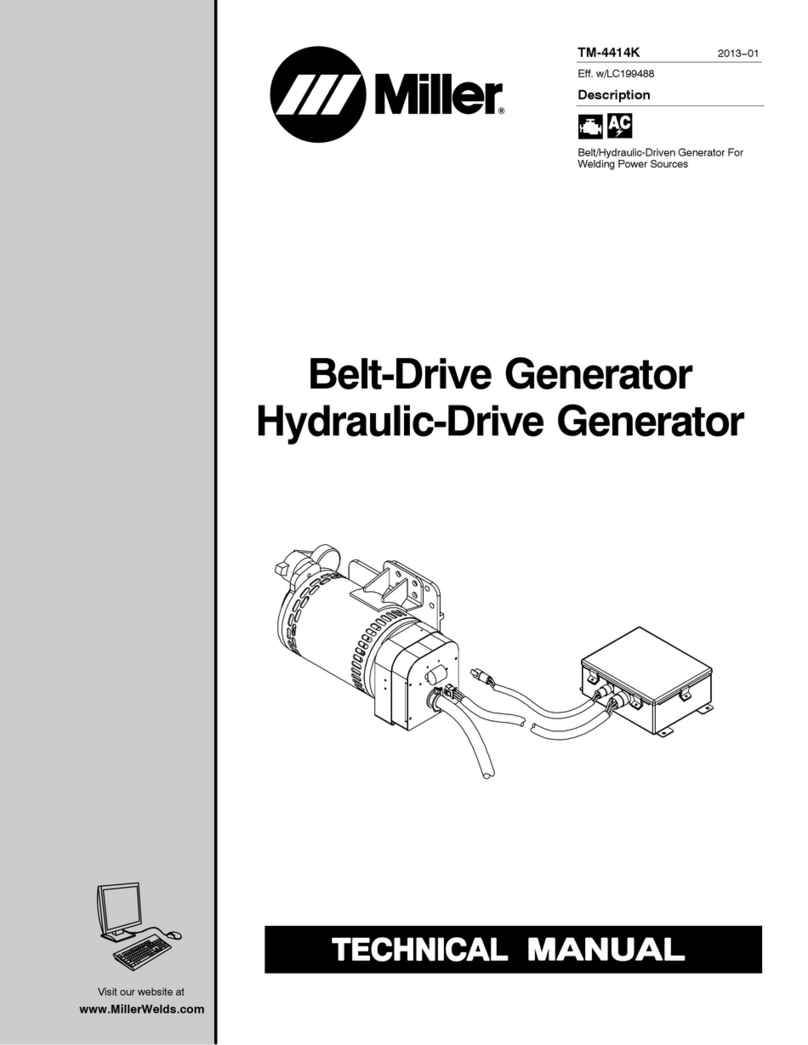
Miller
Miller TM-4414K Technical manual

Rockpals
Rockpals ROCKPOWER 1300 user guide
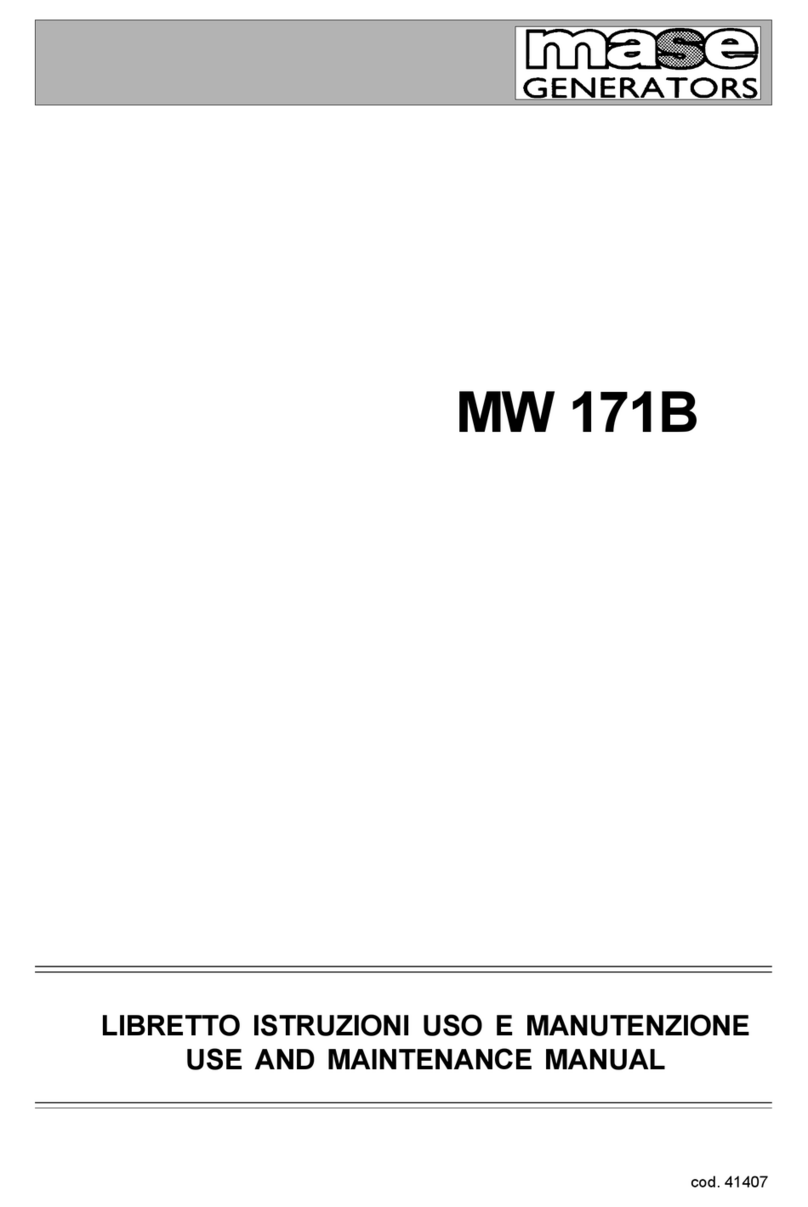
Mase Generators
Mase Generators MW 171B Use and maintenance manual
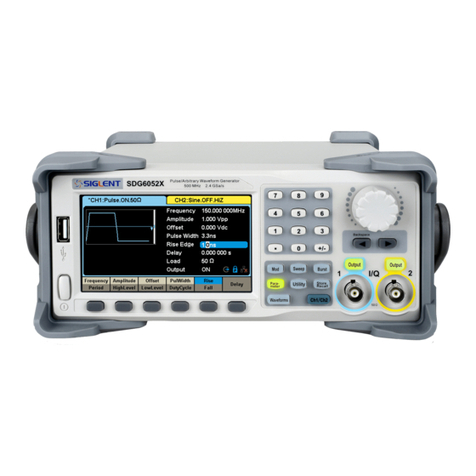
SIGLENT TECHNOLOGIES
SIGLENT TECHNOLOGIES SDG6000X Series user manual
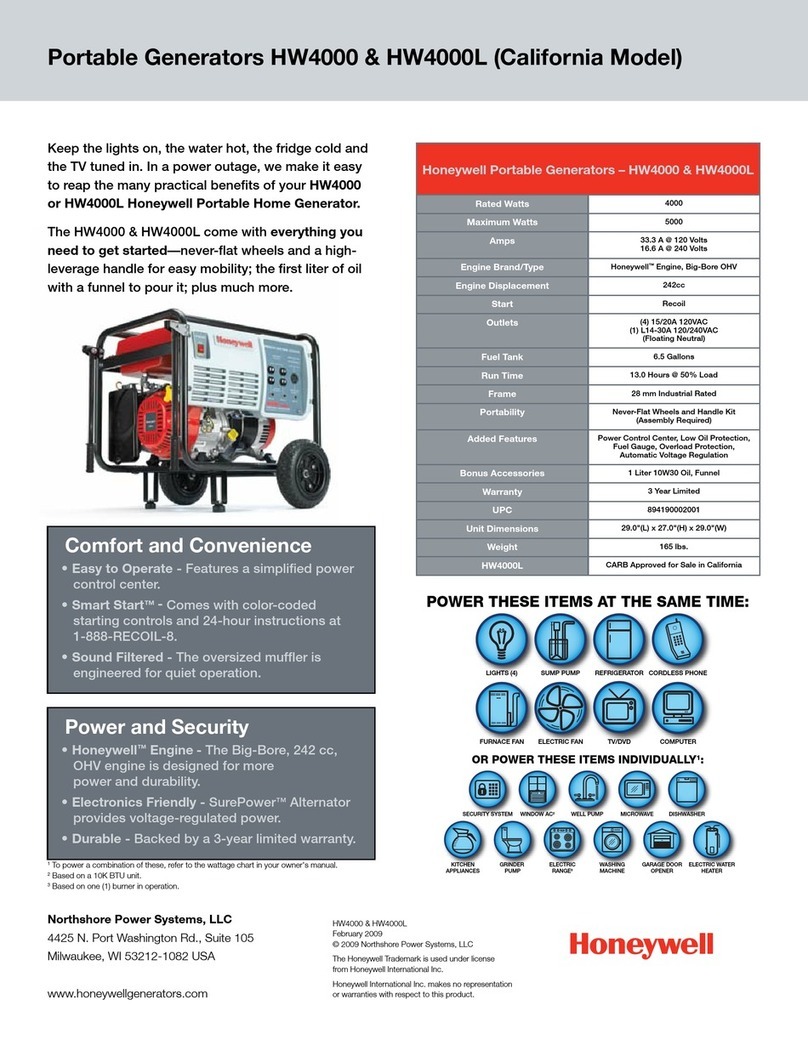
Honeywell
Honeywell HW4000L - Portable Generator Specification sheet
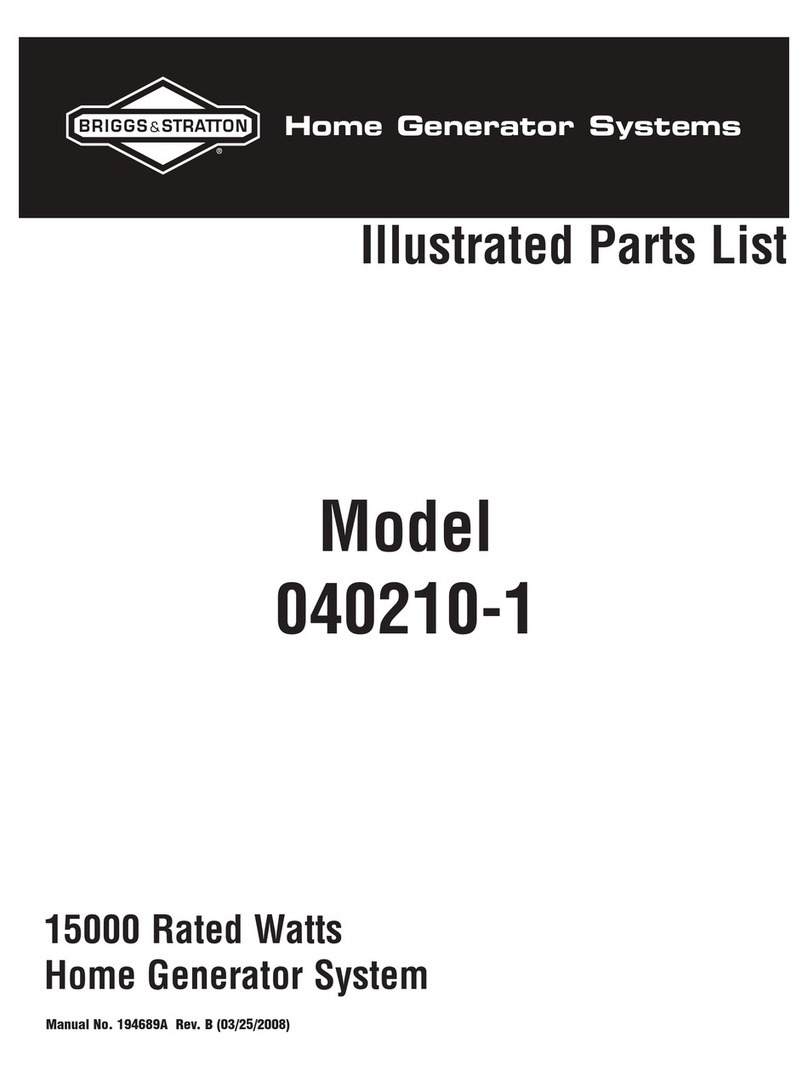
Briggs & Stratton
Briggs & Stratton 040210-1 Illustrated parts list
